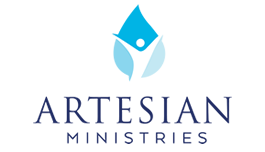Though we did not come during Germany’s famous Christmas markets, Germany is a great place to visit any time of year.
After a good night’s sleep in Berlin following a full day of sites and experiences, our group of 28 travelers crossed the Elbe River and headed to the historic town of Wittenberg – heart of the Protestant Reformation.
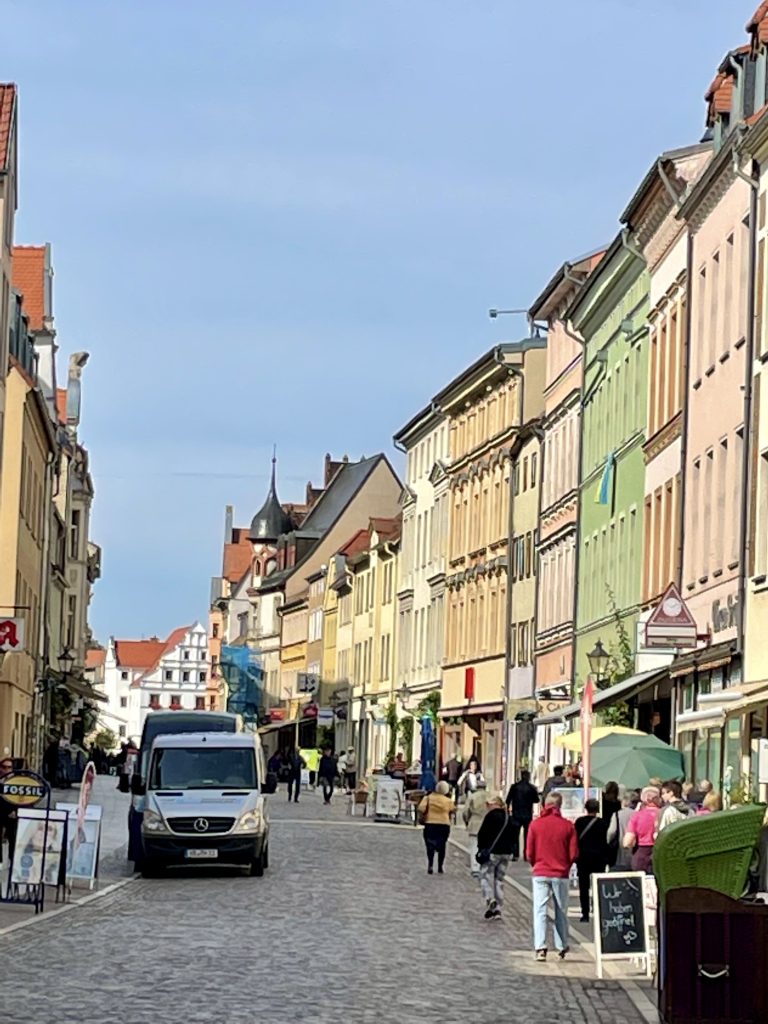
Wittenberg
Wittenberg is a city in north-central Germany along the Elbe River, southwest of Berlin. First mentioned in 1180 and chartered in 1293, it was the residence of the Ascanian dukes and electors of Saxony from 1212 until it passed, with electoral Saxony, to the house of Wettin in 1423.
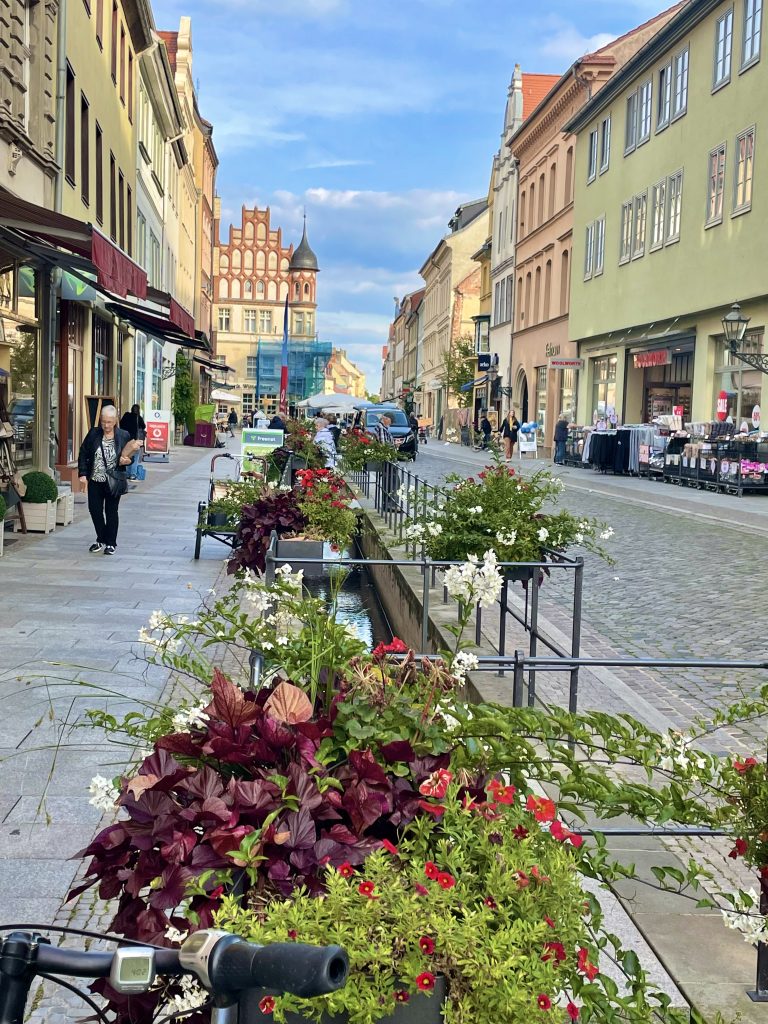
Wittenberg is one of the smaller towns located on the river Elbe and was the launching point for the Protestant Reformation. Martin Luther lived and taught in the city for 36 years.
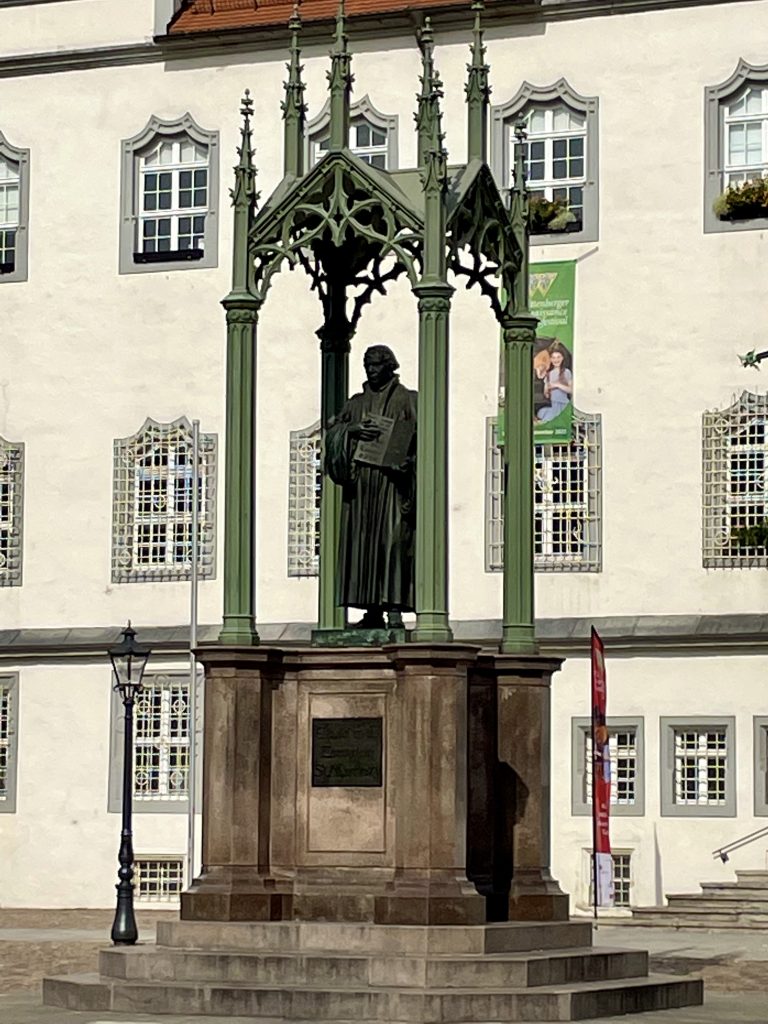
This statute of Martin Luther sits in Wittenberg’s city center. Other reformers left their mark on this city, as well. Unlike many other historic German cities during World War II, Wittenberg’s city center was spared destruction. Walking on those medieval cobblestones felt like stepping back in time!
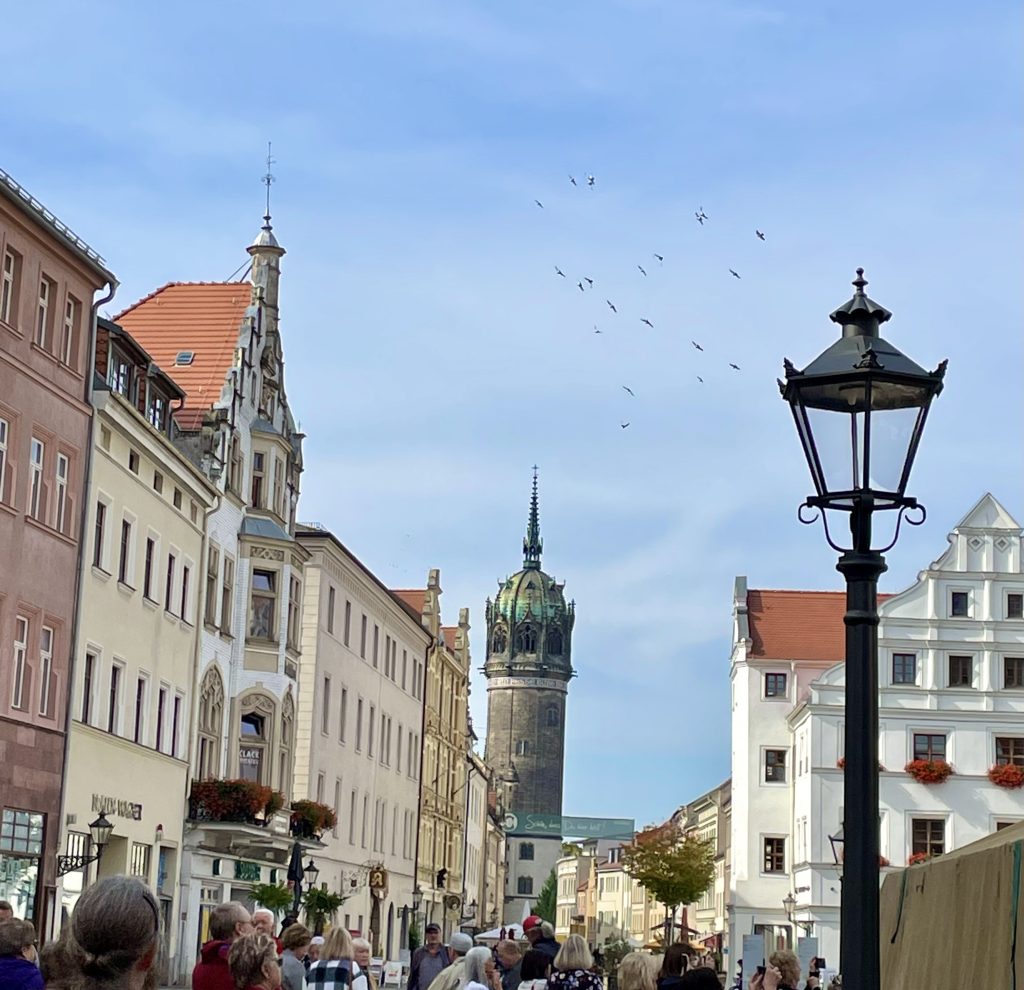
Wittenberg University, made famous by its teachers, the religious reformers Martin Luther and Philipp Melanchthon, was founded by the elector Frederick the Wise in 1502 and merged in 1817 with the University of Halle to form the Martin Luther University of Halle-Wittenberg.
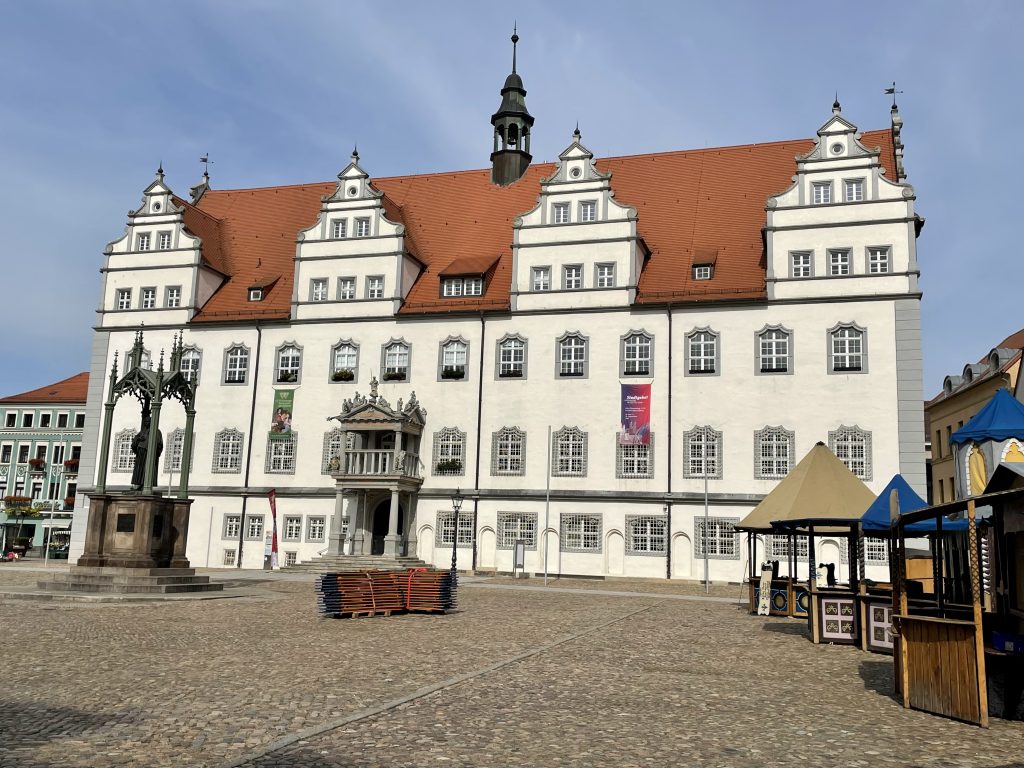
In 1547, when John Frederick the Magnanimous signed the Capitulation of Wittenberg, the electorate passed from the Ernestine to the Albertine line of the Wettins, and the town ceased to be the official residence.
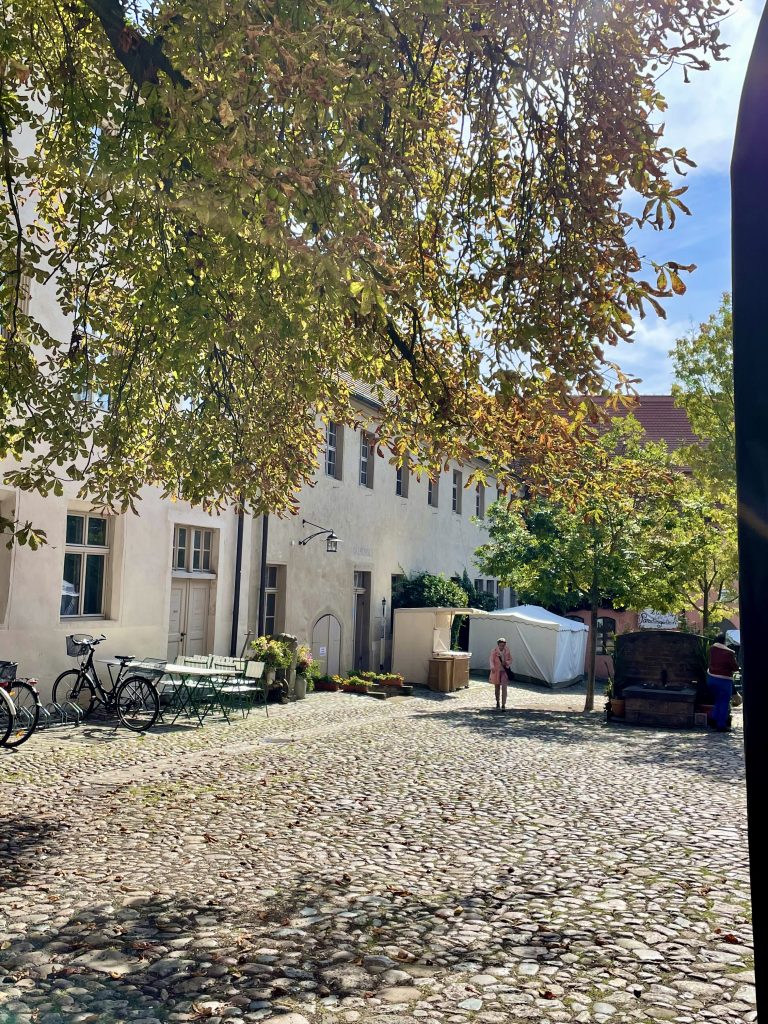
Wittenberg was occupied in 1806 by the French, who strengthened its fortifications in 1813; the fortress was stormed by the Prussians in 1814, and the city was assigned to them in 1815.
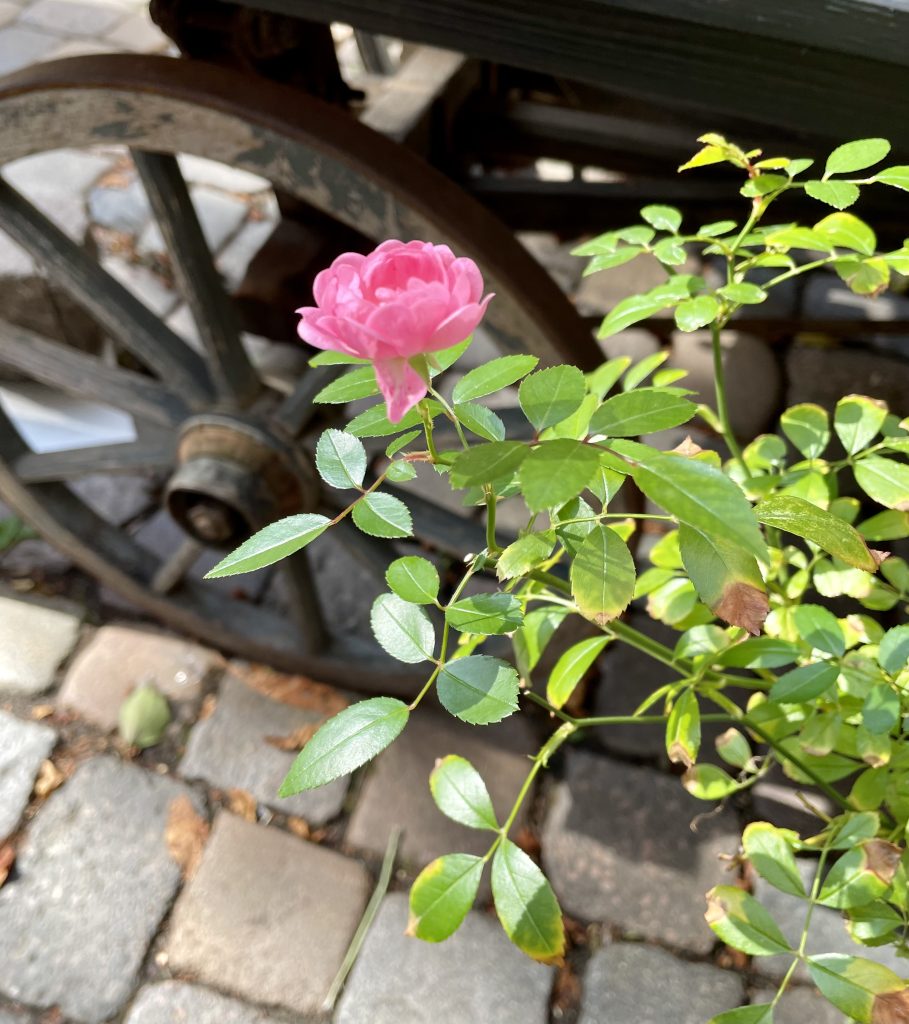
We began our two-and-a-half hour guided tour through the old town and had the best time. It was a beautiful day! We missed the tourist high season and had much of the town to ourselves.
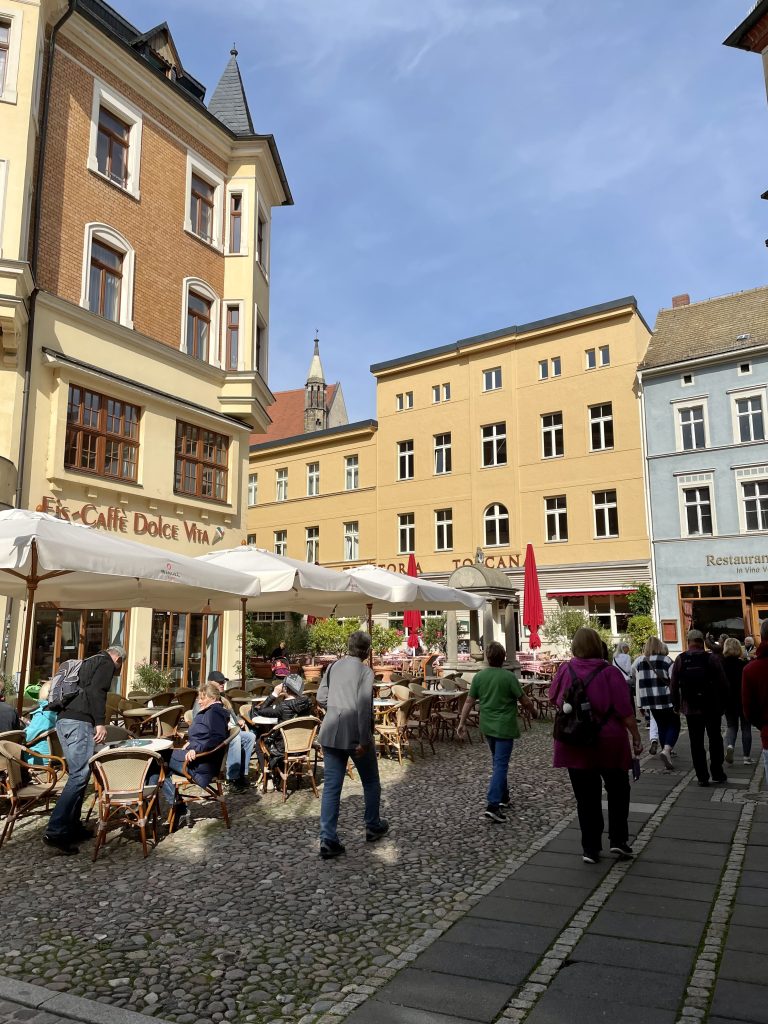
It was a crisp 60-degree day without a cloud in the sky as we strolled along a romantic road comprised of ancient cobblestone streets. The painted shops and traditional German architecture were worth visiting.
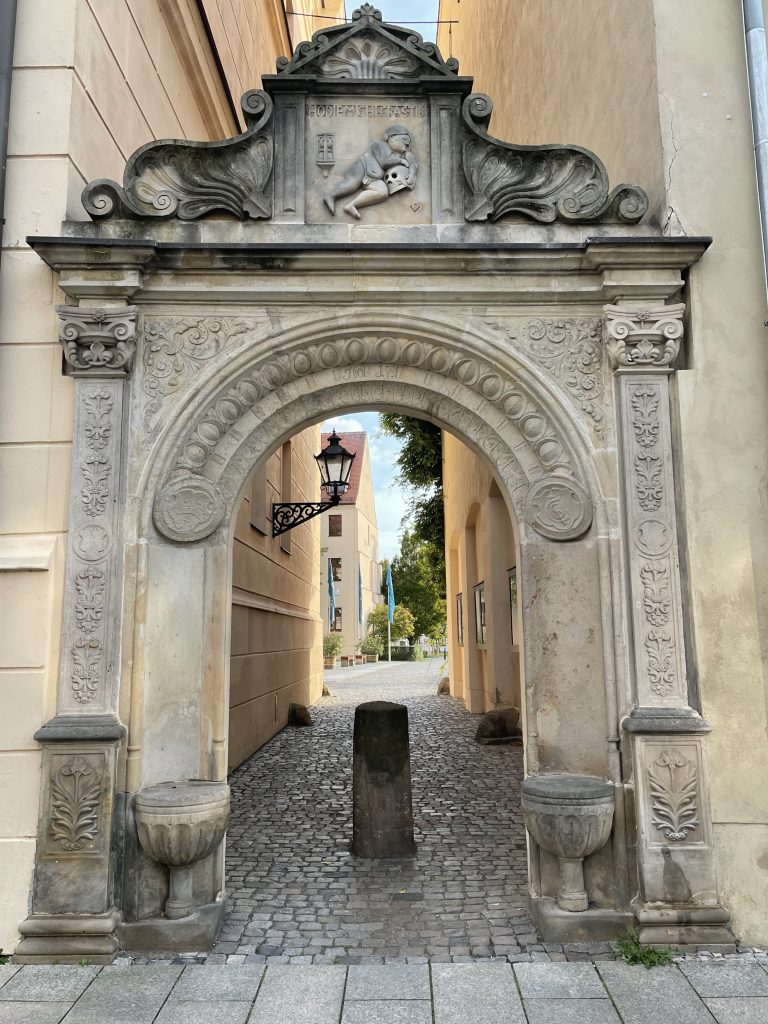
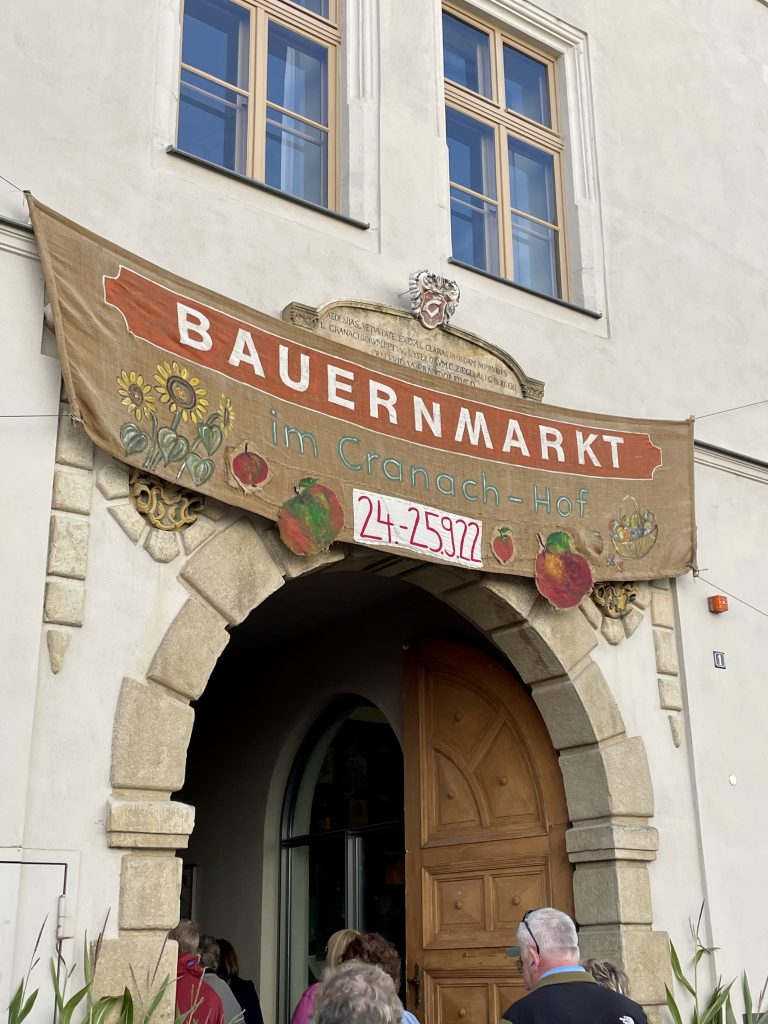
Lutherhaus
Our first stop was the Lutherhaus (Luther House) not far from the main square. When the University of Wittenberg opened in 1503, Luther House was built in 1504 as an Augustinian monastery. Known at the time as the “Black Monastery,” the name alluded to the cowl color of the Augustinian monks.
In 1507, after being ordained as a priest, Martin Luther lived in the monastery until in 1521, when he was forced to hide in Wartburg Castle to preserve his life and continue his work.
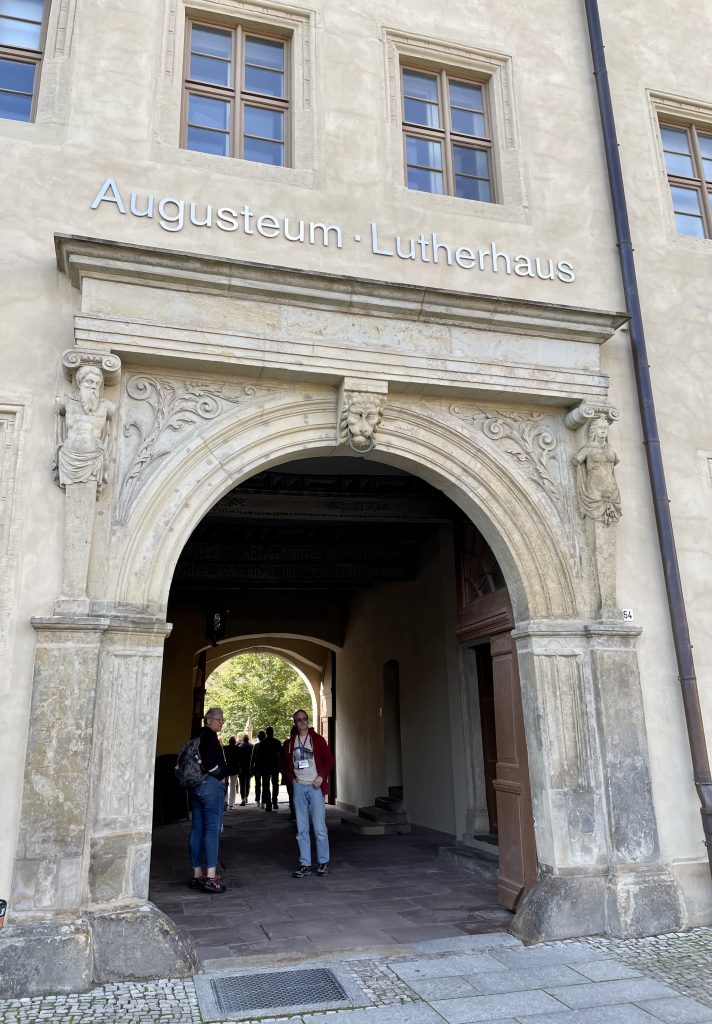
Passing through the medieval portico into the Lutherhaus felt surreal.
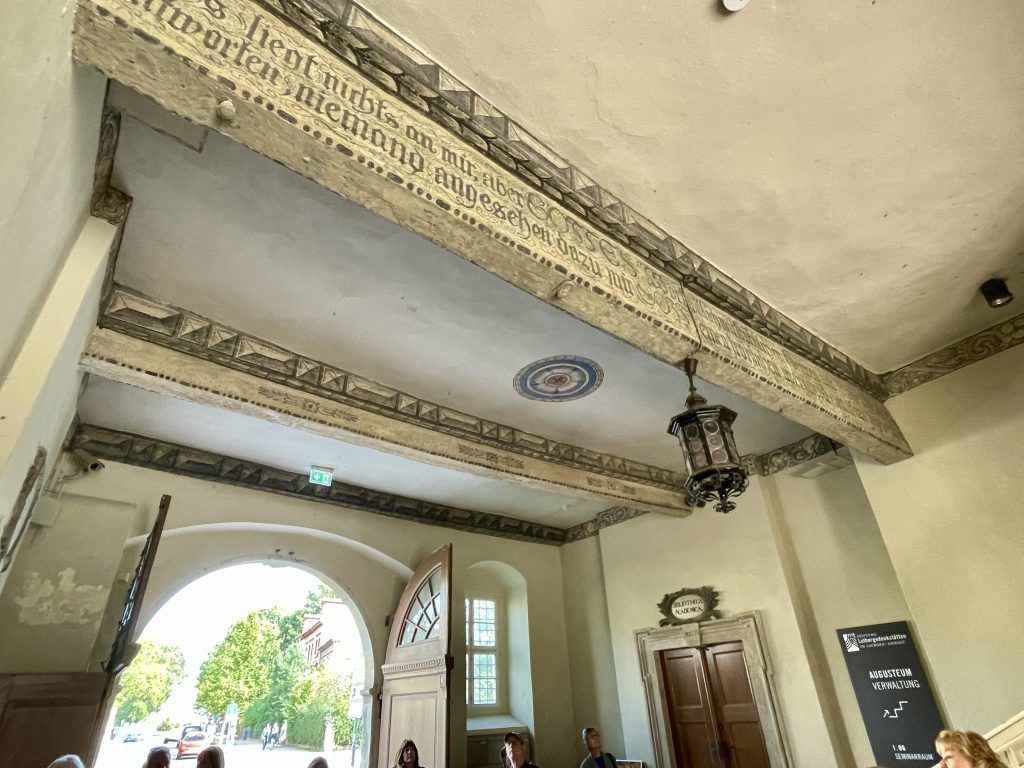
On the ceiling over the entryway doors (above) are beautifully carved and frescoed beams, along with a colored drawing of Luther’s seal.
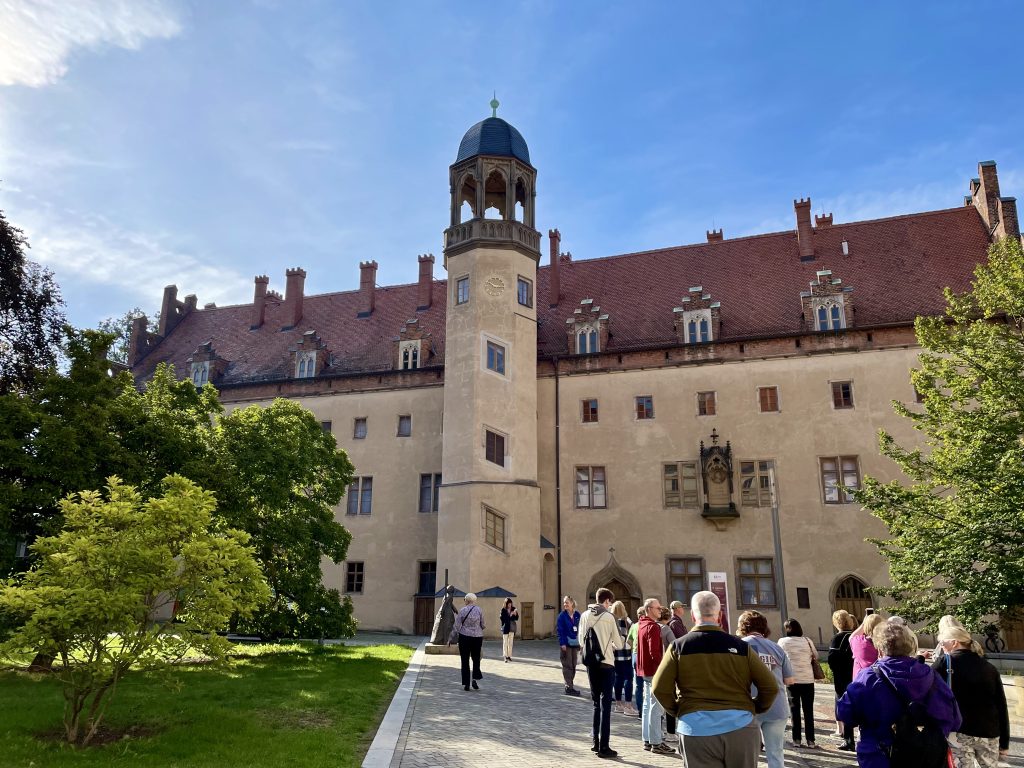
The Lutherhaus courtyard is beautifully maintained.
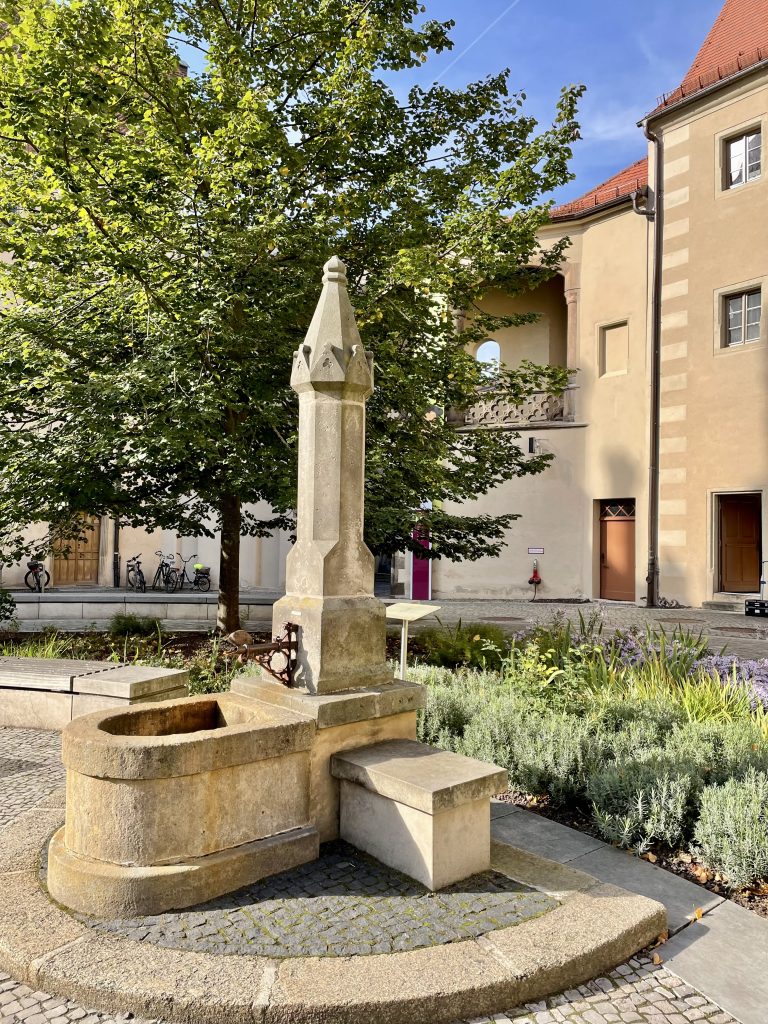
This original fountain still offers running water today. The flowing stream glistens in the morning sunlight.
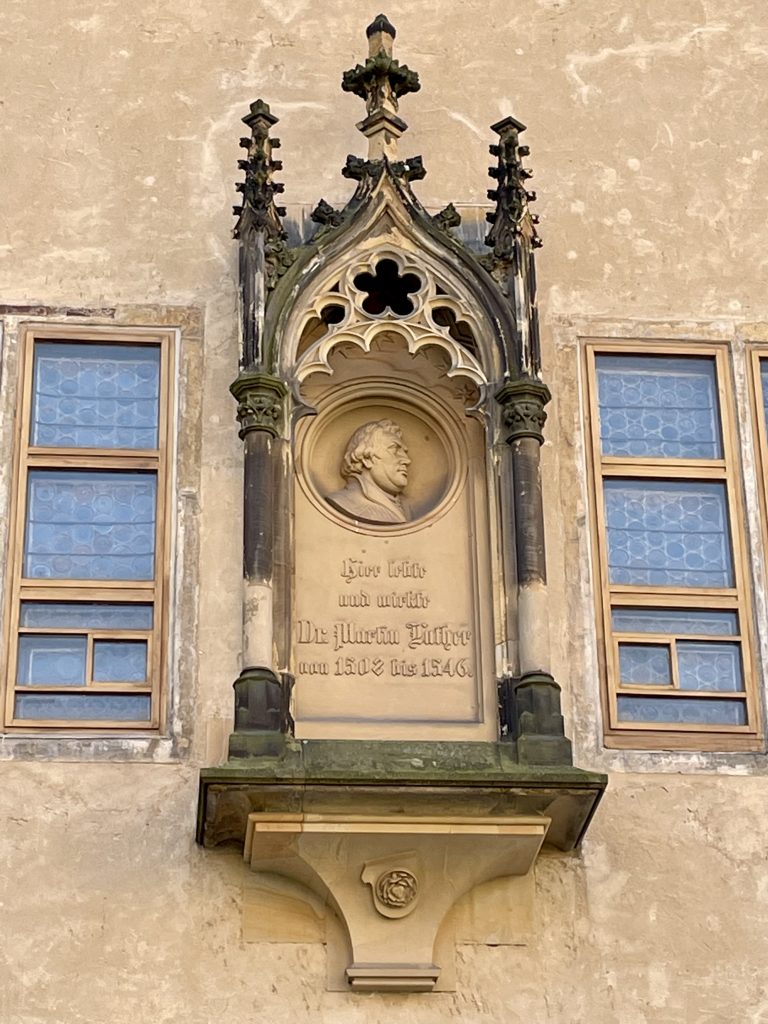
Luther’s wife Katharina von Bora gifted her husband with a portico (below). At the end of long days they each had a place to sit outside on either side of the door to pause, reconnect and exchange tidbits of their day’s adventures.
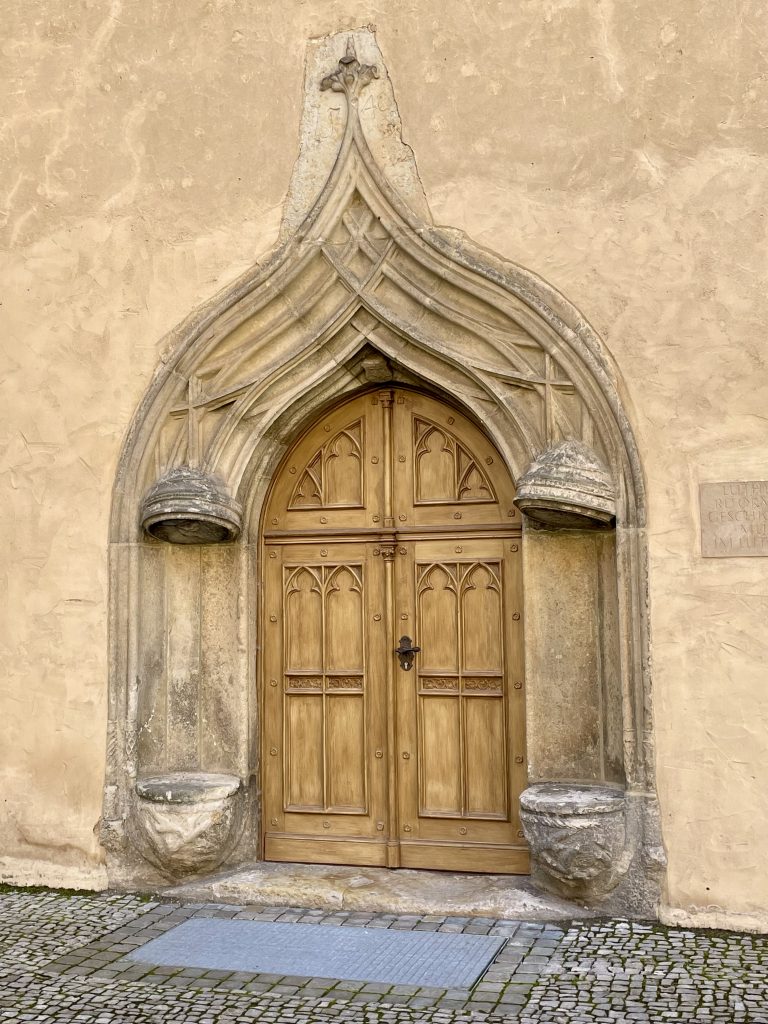
Above each seat, Katharina commissioned special carvings. Above Luther’s seat on the left, she had a likeness of his face etched.
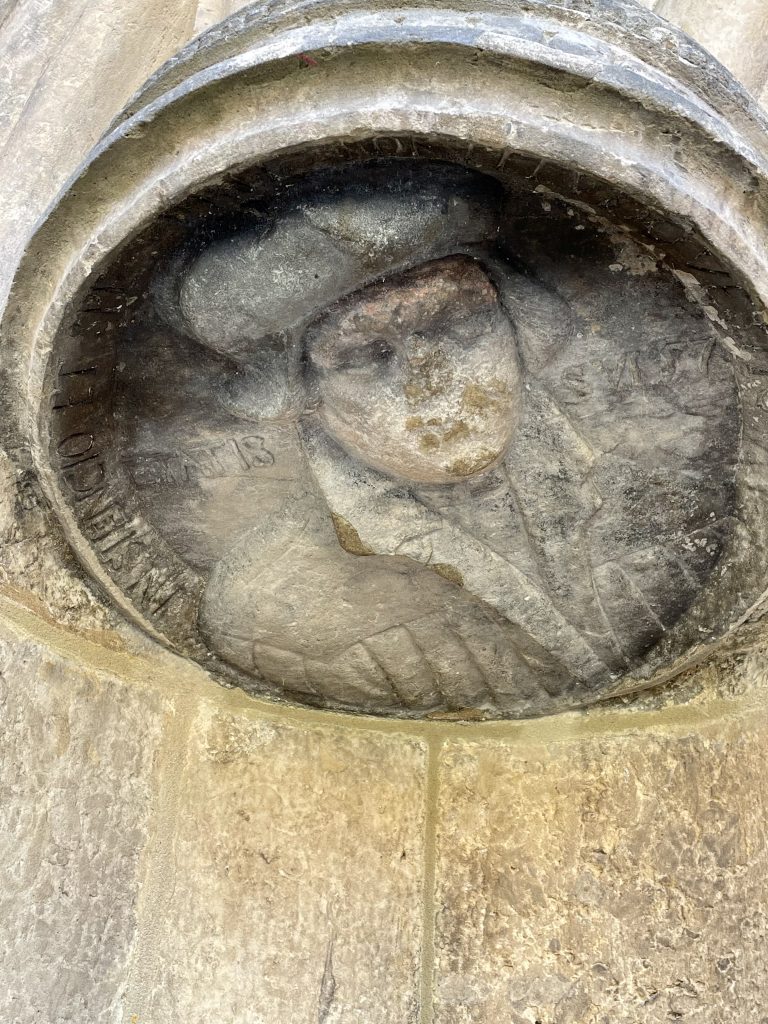
Above her seat on the right, Katharina had a likeness of Luther’s seal etched.
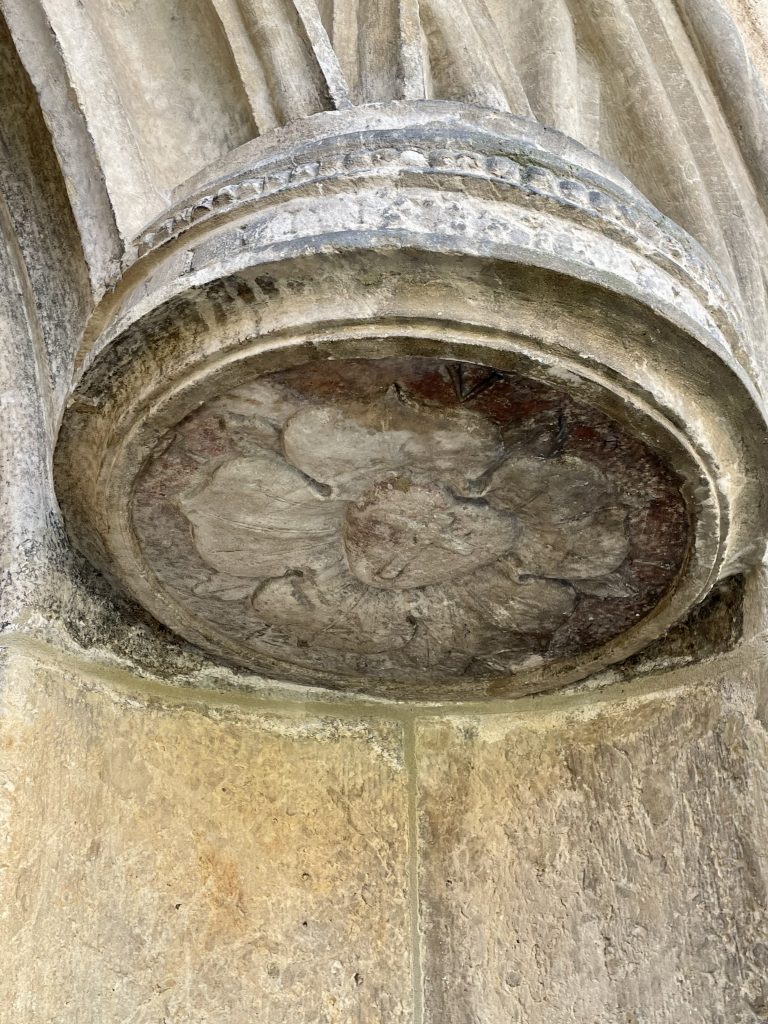
The inside of their home is preserved precisely how they left it. The wooden boards creaked underfoot and the walls whispered history with each breeze.
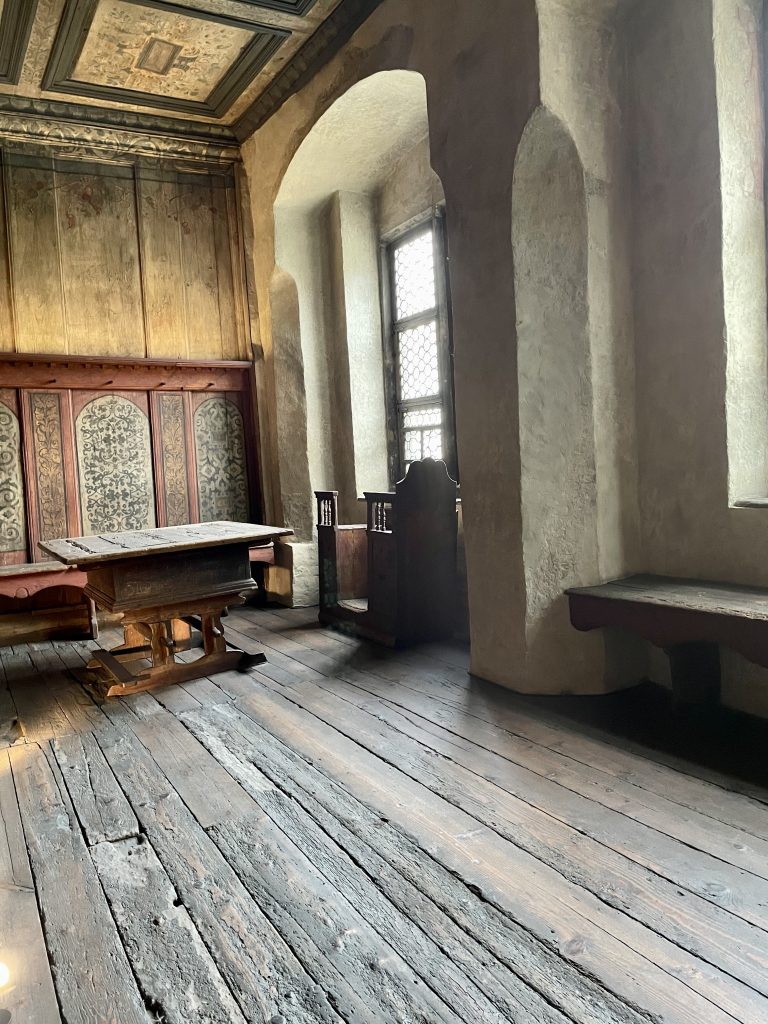
Martin and Katharina ate at this dining table and sat in those window seats to exchange the day’s news. Luther paced on these very wood floors.
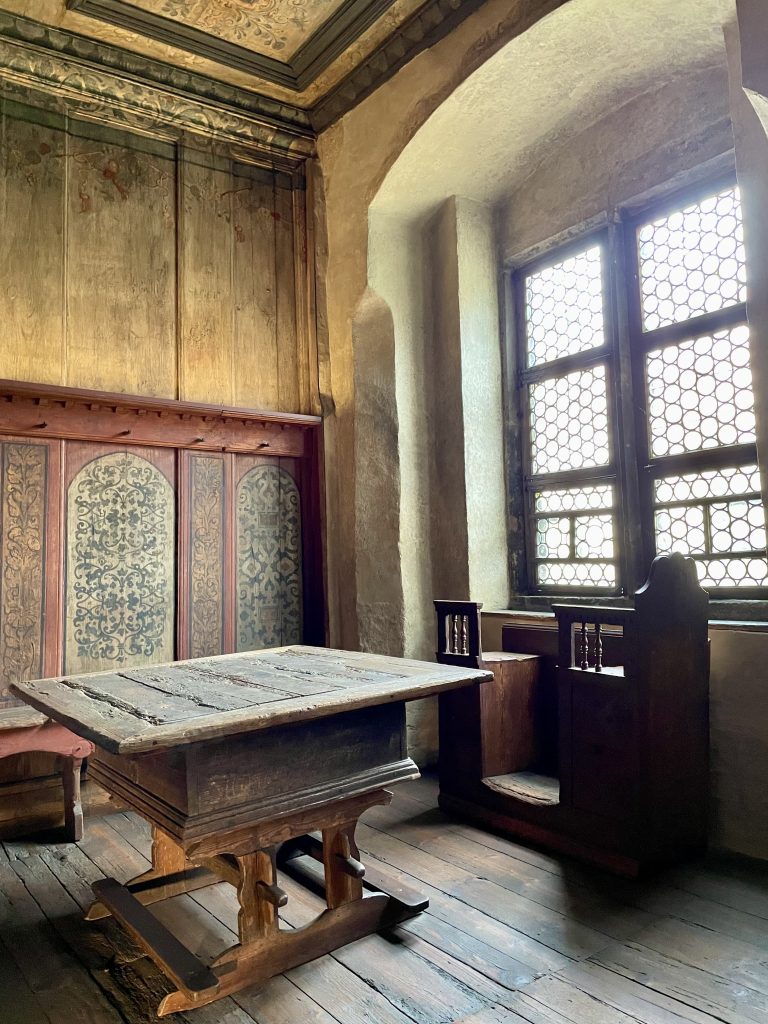
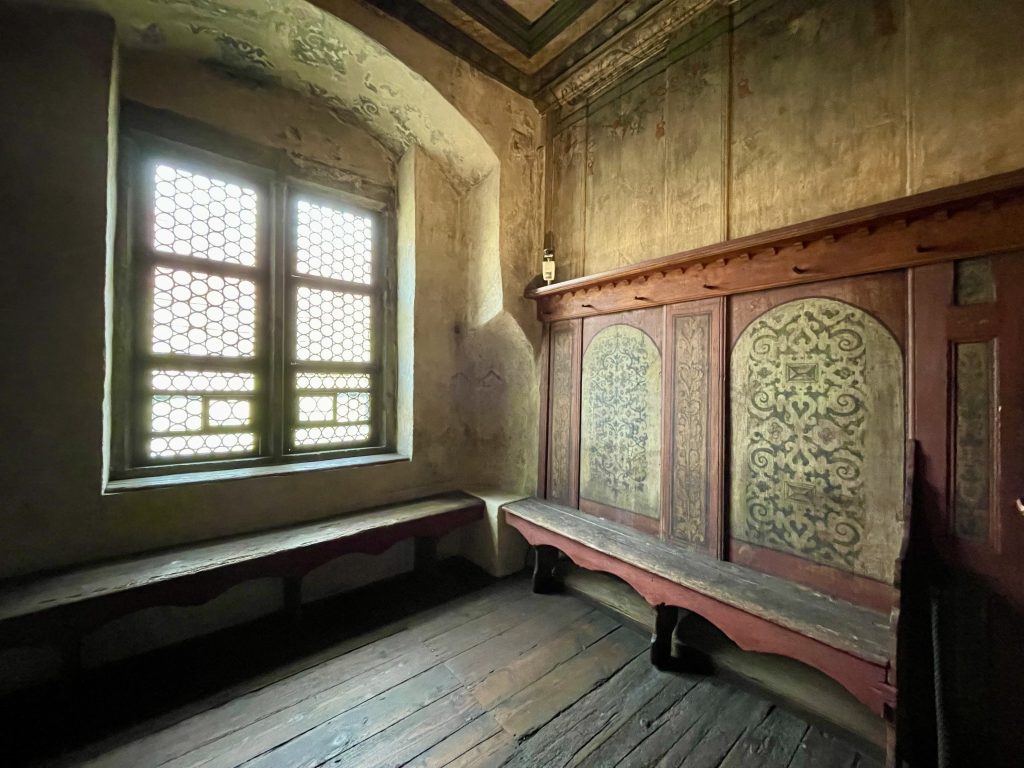
The ceiling holds evidence of smoke from fires lit in the medieval heating tower to keep them warm during Wittenberg’s frigid winters.
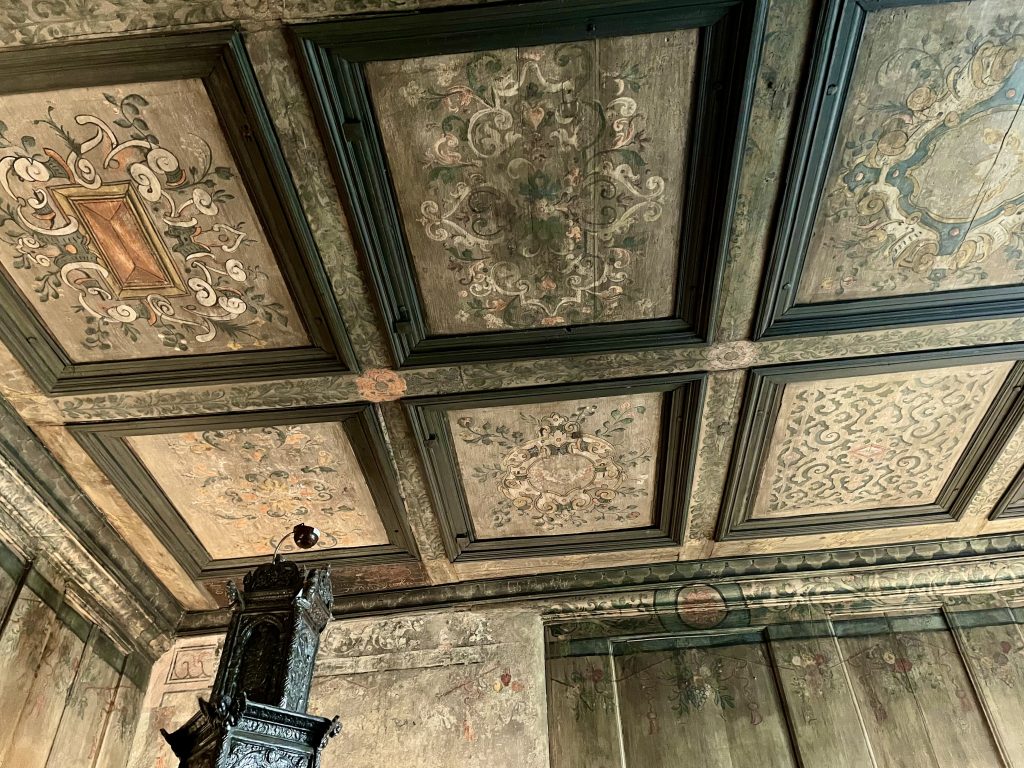
Medieval heating stove used to keep the Martin and Katharina warm on chilly days.
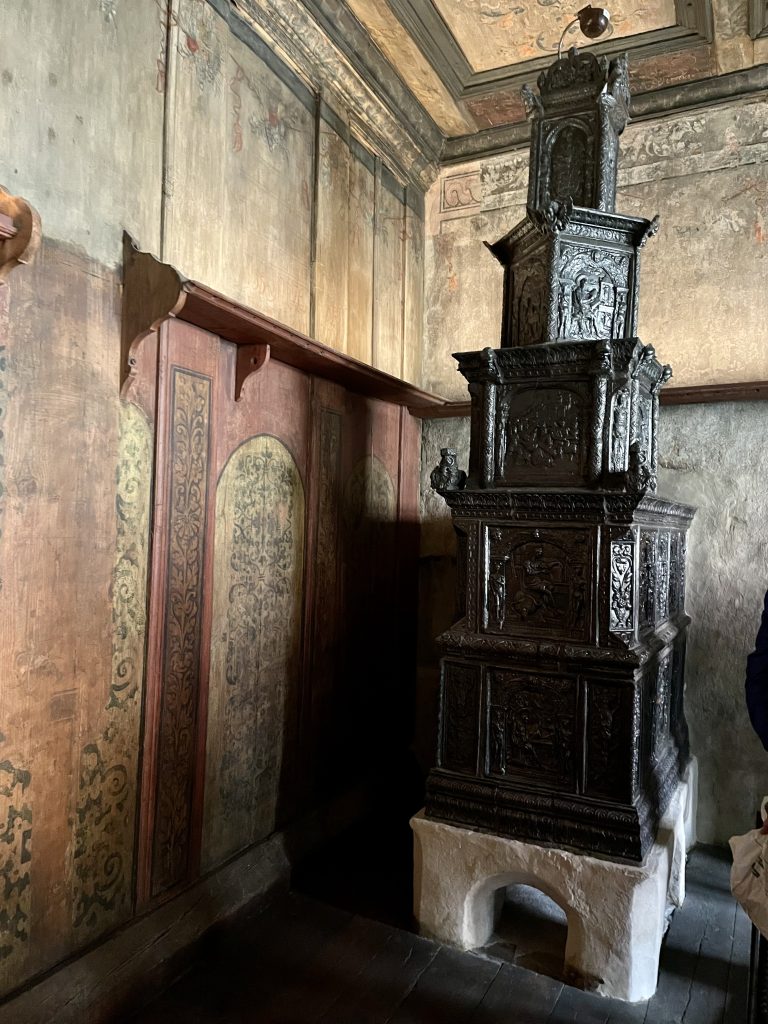
Carefully preserved behind ropes, Martin and Katharina went in and out of this very door. The original latch is quite impressive in size, though hard to ascertain from a distance.
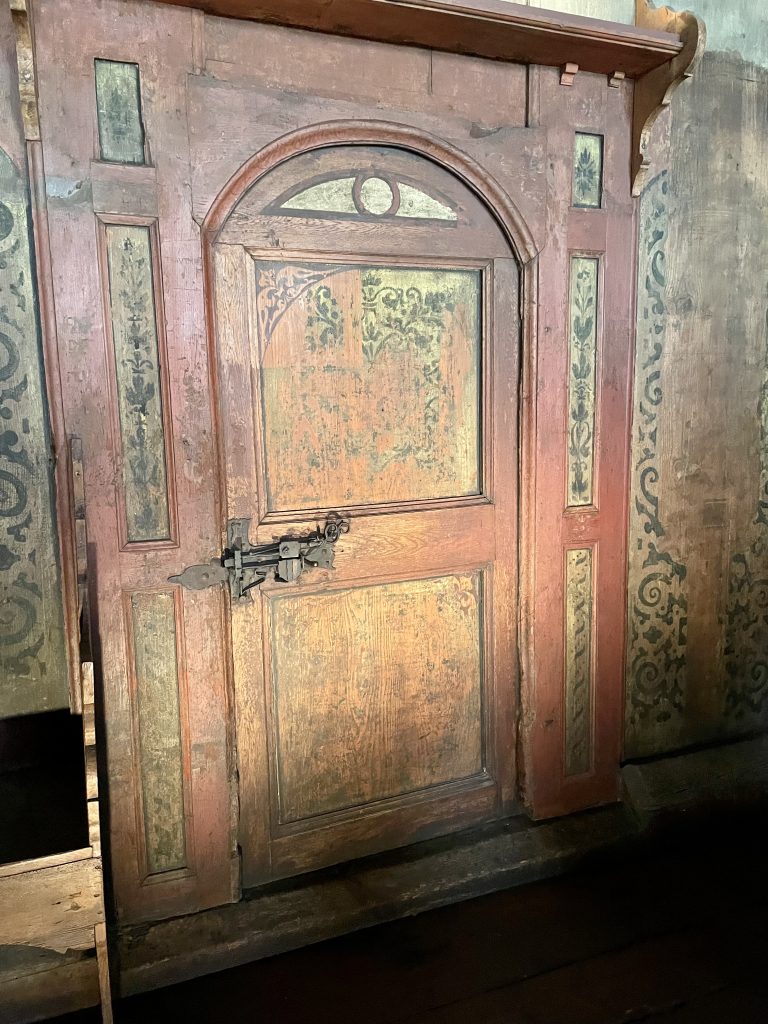
In 1524, after Luther had returned to Wittenberg, the abandoned monastery was given to him as his home. He lived there until his death in 1546.
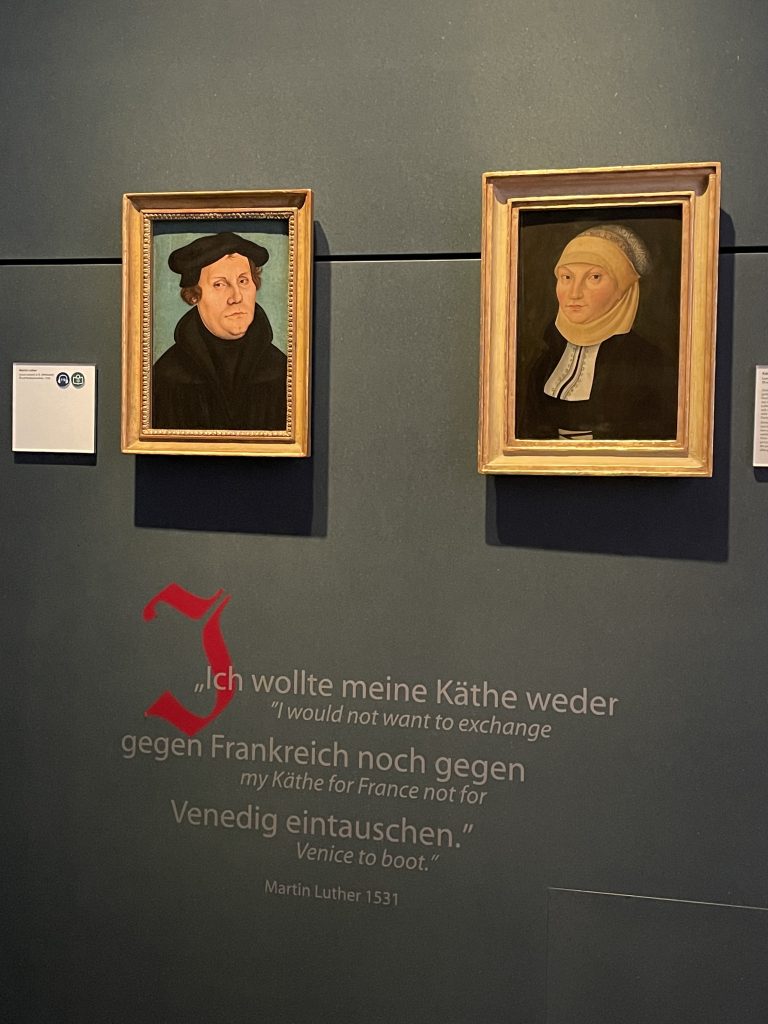
As we exited the Luthers’ well-preserved home interior, this plaque containing their portraits greeted us: “I would not want to exchange my Kathe for France not for Venice to boot.” Martin Luther, 1531.
Lutherhaus Permanent Exhibit
The Lutherhaus is now the world’s largest Protestant Reformation museum. On display are Luther’s pulpit, his monk’s habit, his Bible, and many priceless papers, manuscripts, and pamphlets.
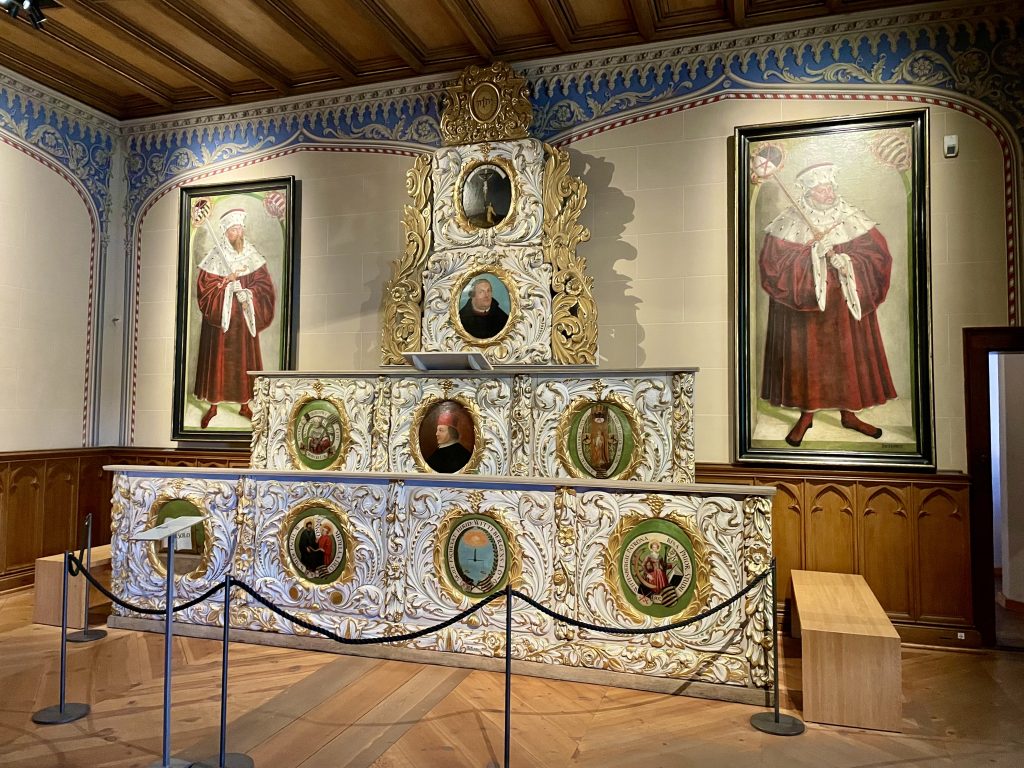
This lectern was used regularly during recurring scholarly debates, so-called disputations. The chairperson of the disputation puts forward theses, which students are to attack or defend. The lowest part shows the coat of arms of the philosophical, the theological, the legal as well as the medical faculties.
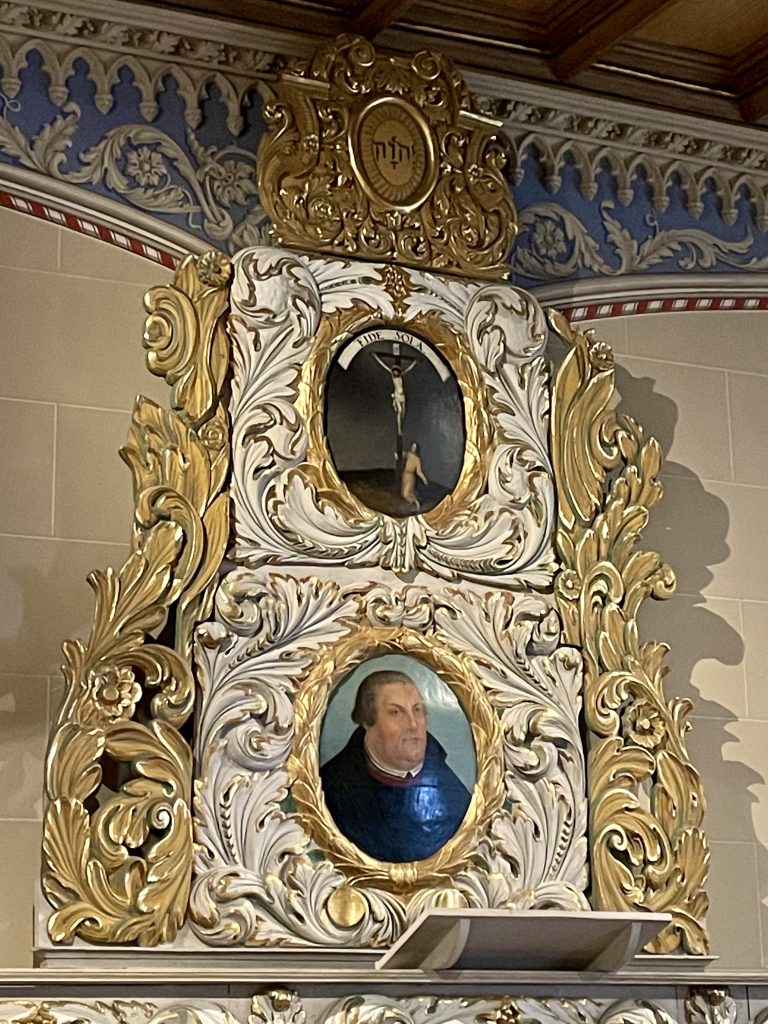
A Luther portrait(above) is located in the center. Right above him we see an allegory of faith and the Hebrew name of God.
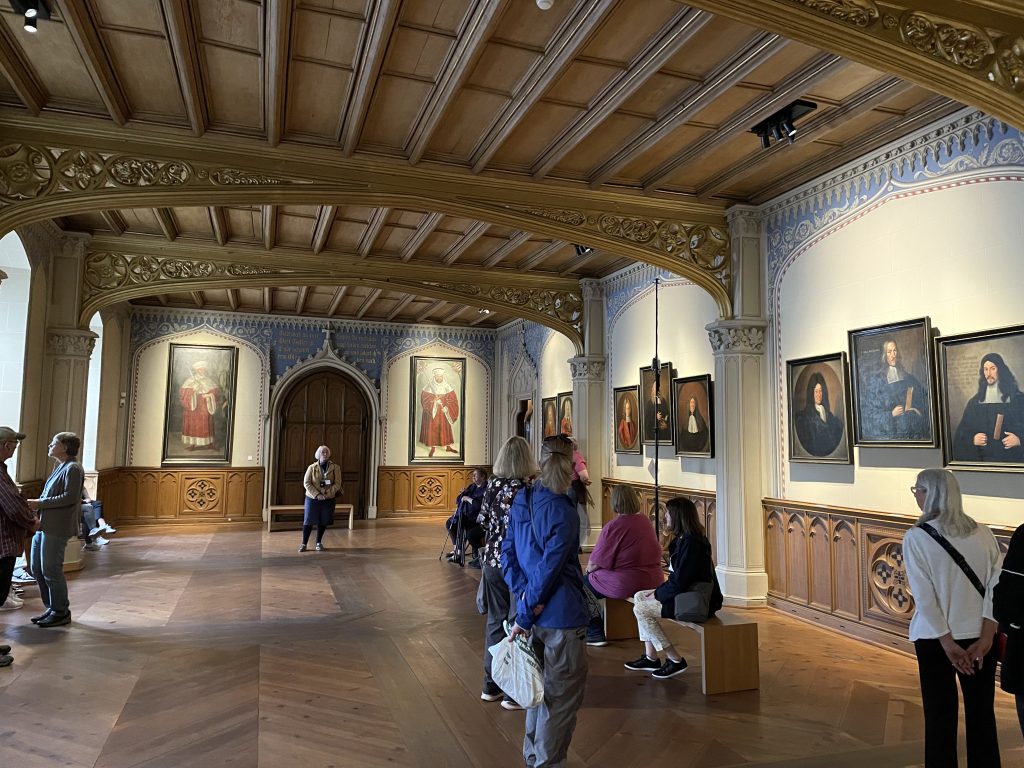
Lining the walls of the hall containing the lectern are many portraits of famous theologians and Reformers.
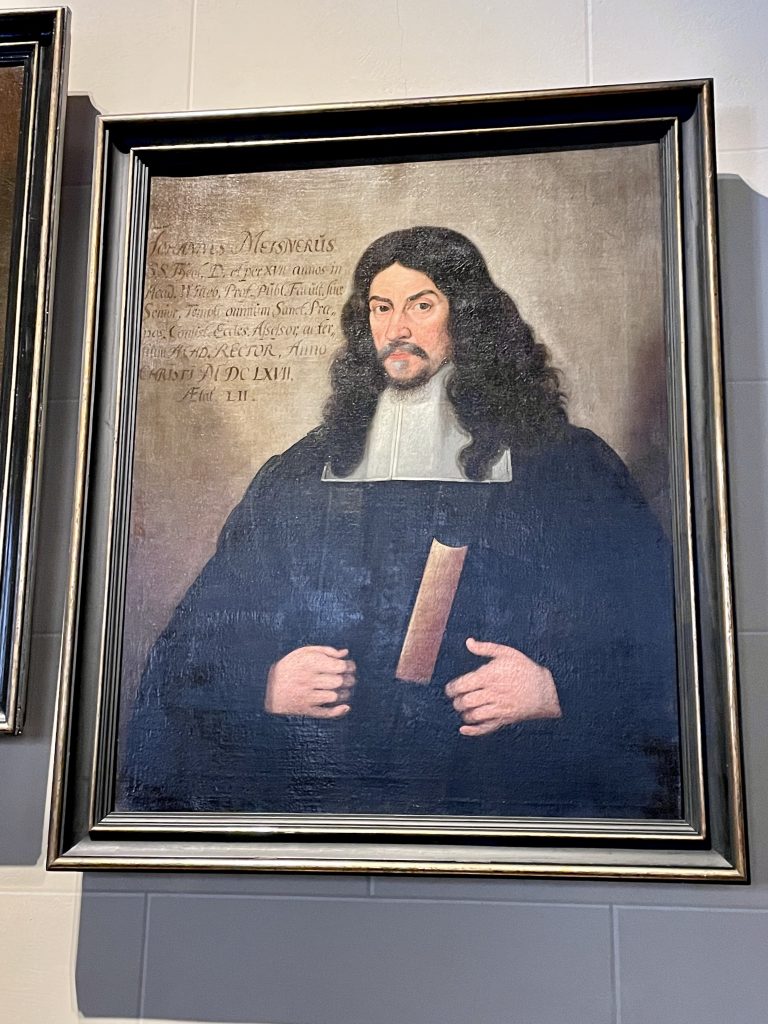
Figuring prominently in the room is this painting of Johannes Meisner (1615-1684), who served as a Professor of Theology at the University in 1667.
The Printing Press
Johannes Gutenberg is known as the “Father of Printing” because he was the first to combine the use of molded movable metal type, a press, and printer’s ink. Although not an original, a replica is displayed at the Lutherhaus.
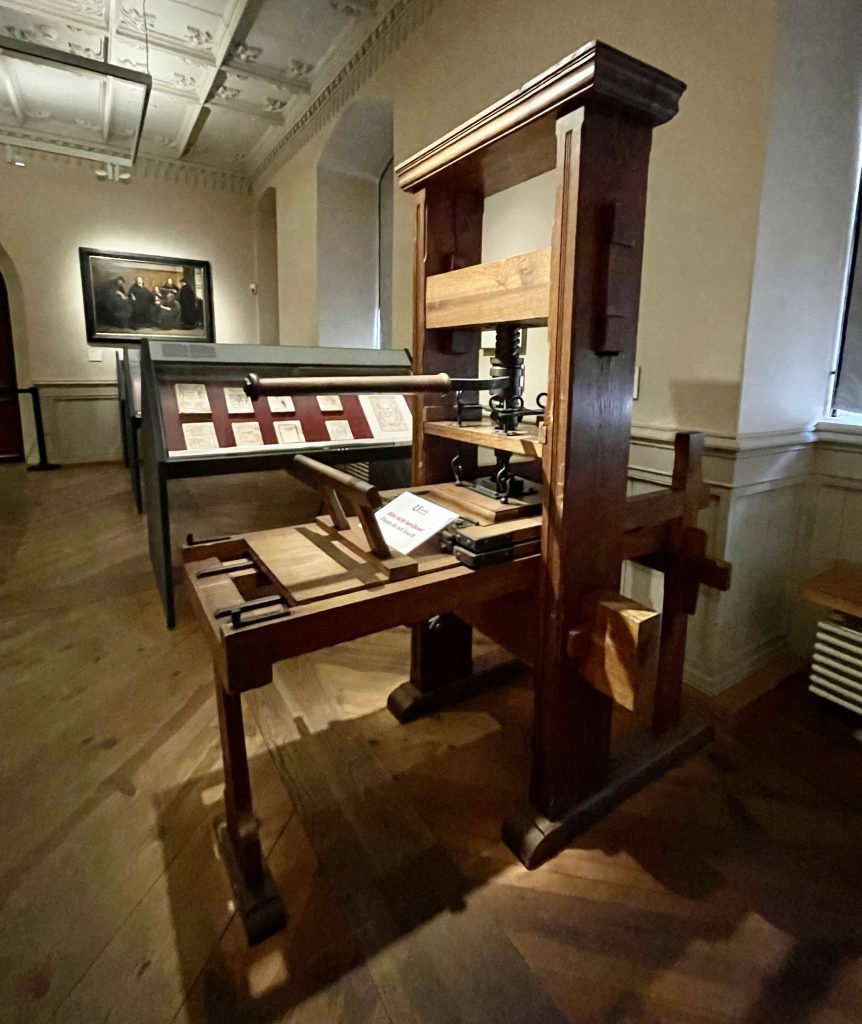
Luther took full advantage of the modern technology of the printing press to reproduce his translated Bible and many sermons.
Luther’s Prayer Book
Luther’s prayer book was published for the first time in 1522. Beside his Bible translation and the Small Catechism, it was Luther’s most frequently read book.
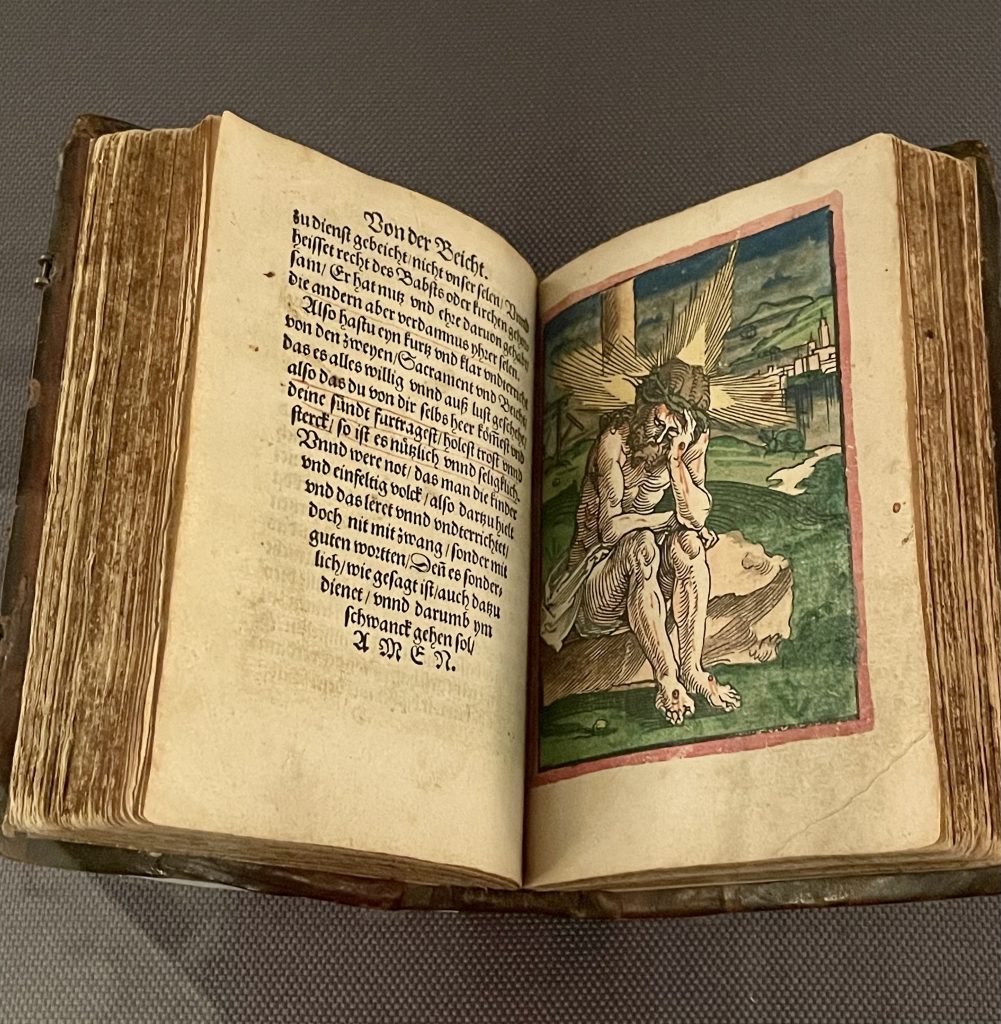
Thirty-seven more editions were published within Luther’s lifetime. Apart from the Nuremberg print, the copy displayed here at the Lutherhaus is the only other original in existence.
A Mighty Fortress Hymn
The earliest print of Luther’s Autumn 1527 written hymn, “A Mighty Fortress is Our God” can be found in the first edition of Joseph Klug’s hymn book from 1529. Not one single copy of that edition came to the Lutherhaus. In 1932, they acquired the only known copy of this second edition from 1533.
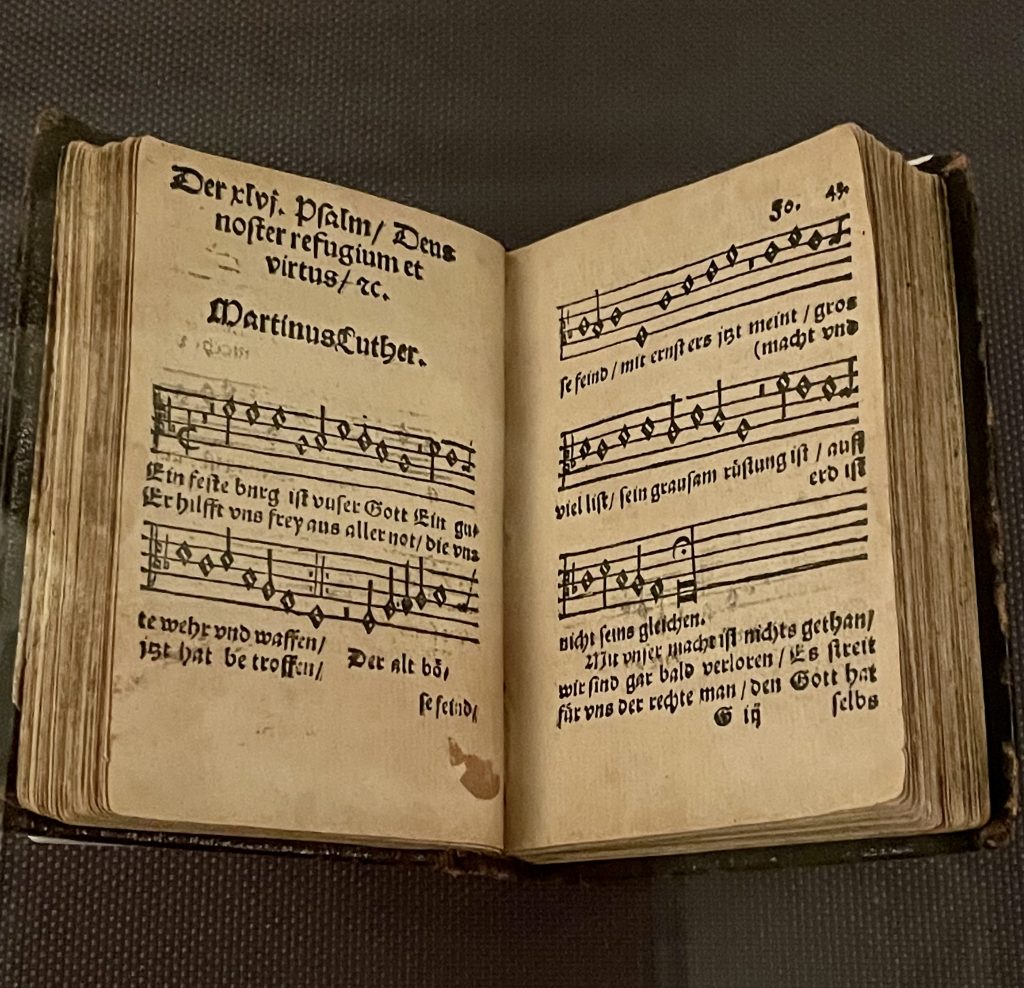
Luther’s Bible
Below is the first complete edition of Luther’s Bible translated in the High German language.
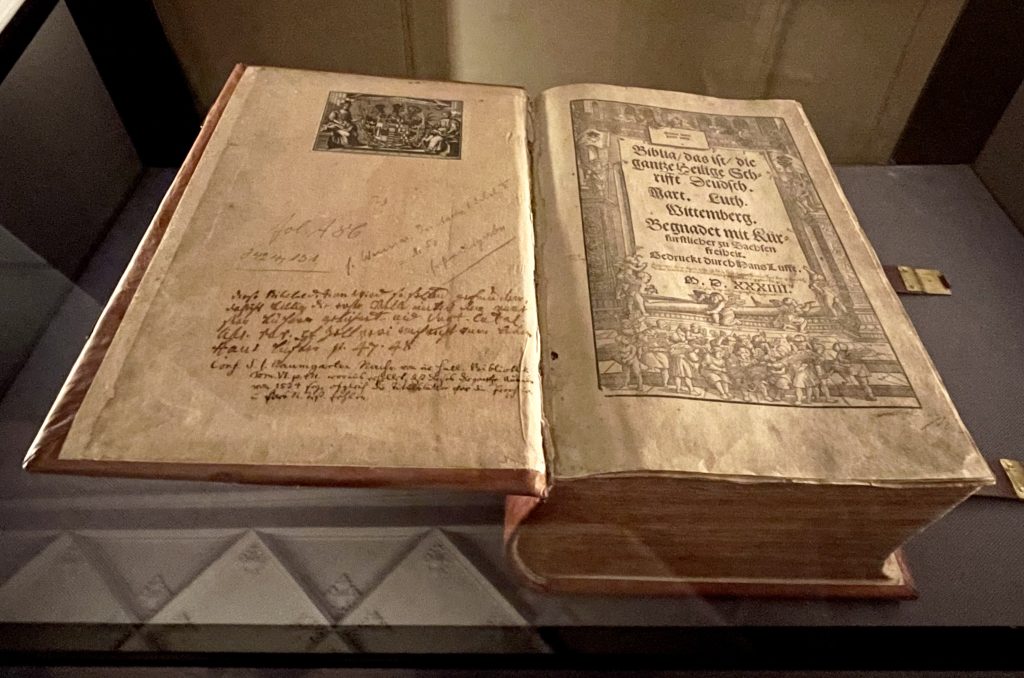
While Luther is best known as the father of that Reformation, he’s also the father of the German language as we know it. Before Luther, there was no single German language — just a series of dialects. Two in particular were dominant: Upper German and Low German. As a child, Luther lived on the linguistic borderlands that divide the two, and his family moved back and forth across the boundary several times.
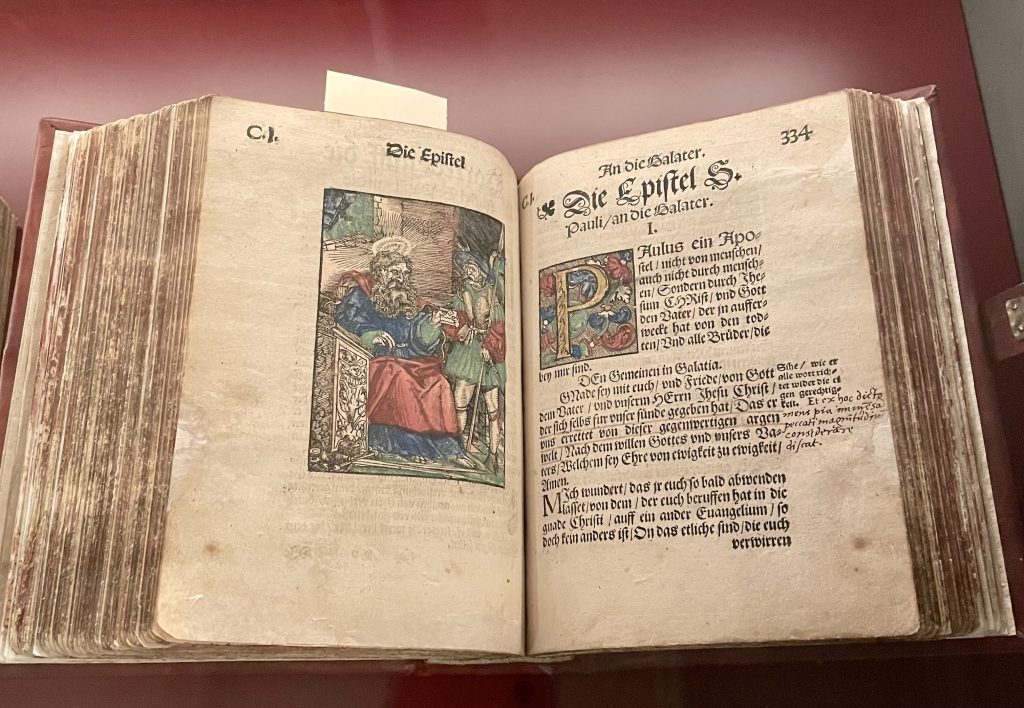
As Luther translated the Bible into German for everyday worshippers, that fluency helped him craft a version of the language that everyone could understand.
Luther on Indulgences
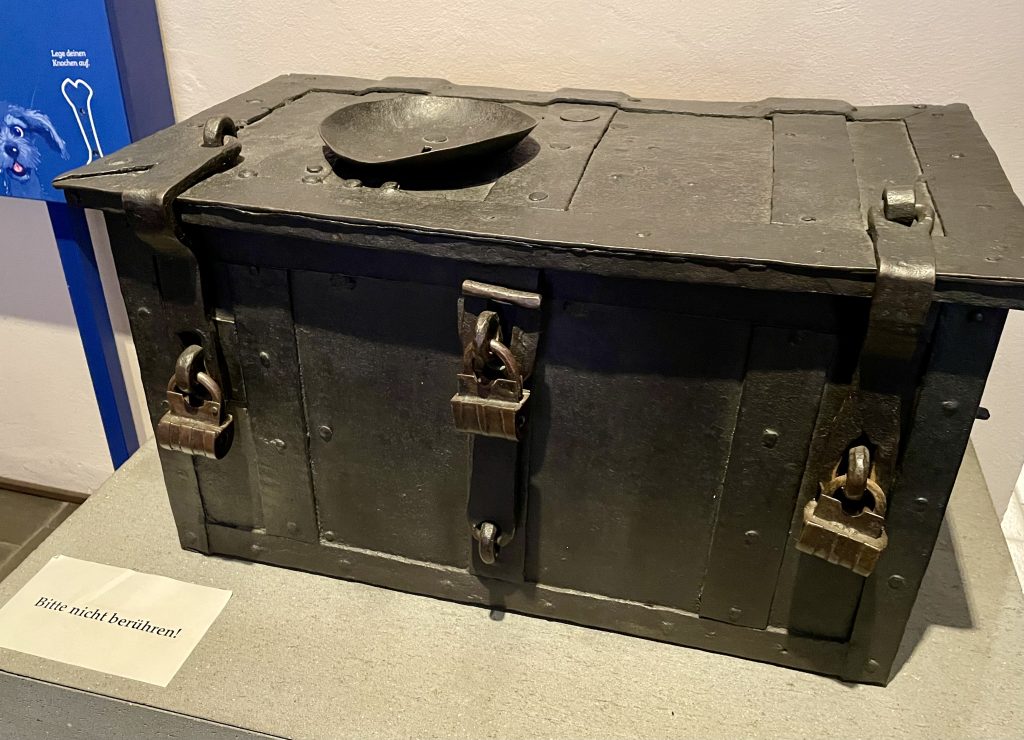
This was a traditional indulgence chest, where a Franciscan monk or priest read out the text of a papal bull of indulgence at a church. In the center of the wood-cut a citizen would place a coin into the chest, being overseen by another monk.
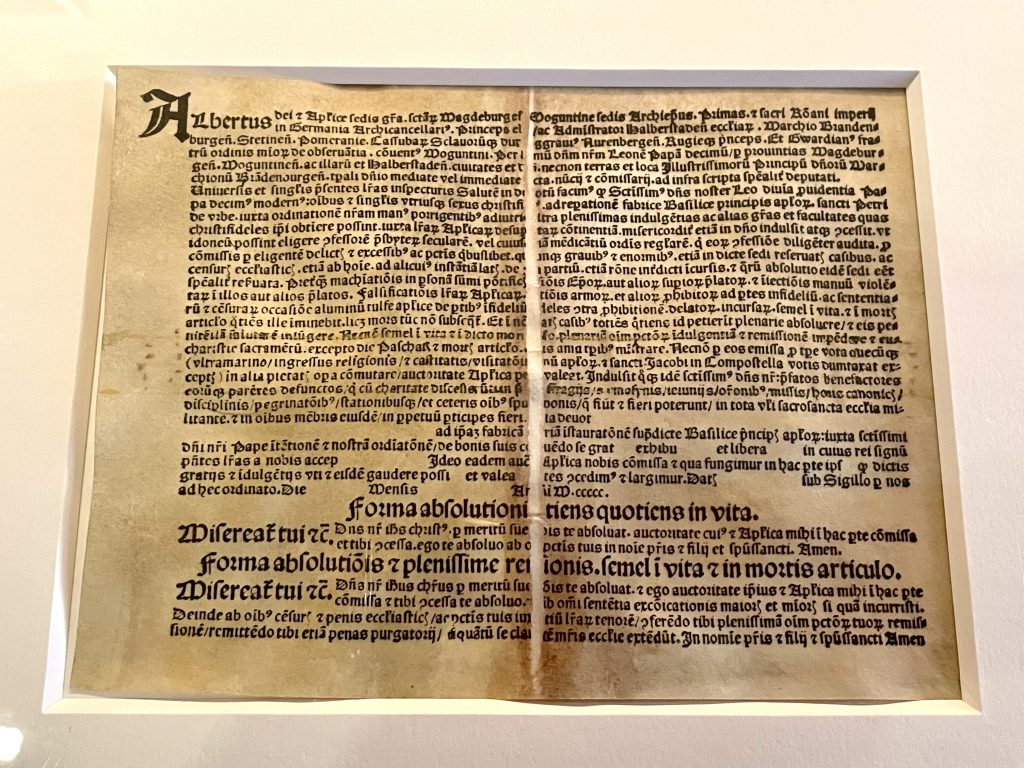
Believers could purchase this form (above) from indulgence preachers once his payment had been received. The priests taught that this form conferred the right to believers to confess his sins once in his life and at his hour of death to a priest in order to be granted complete absolution, and release from purgatory.
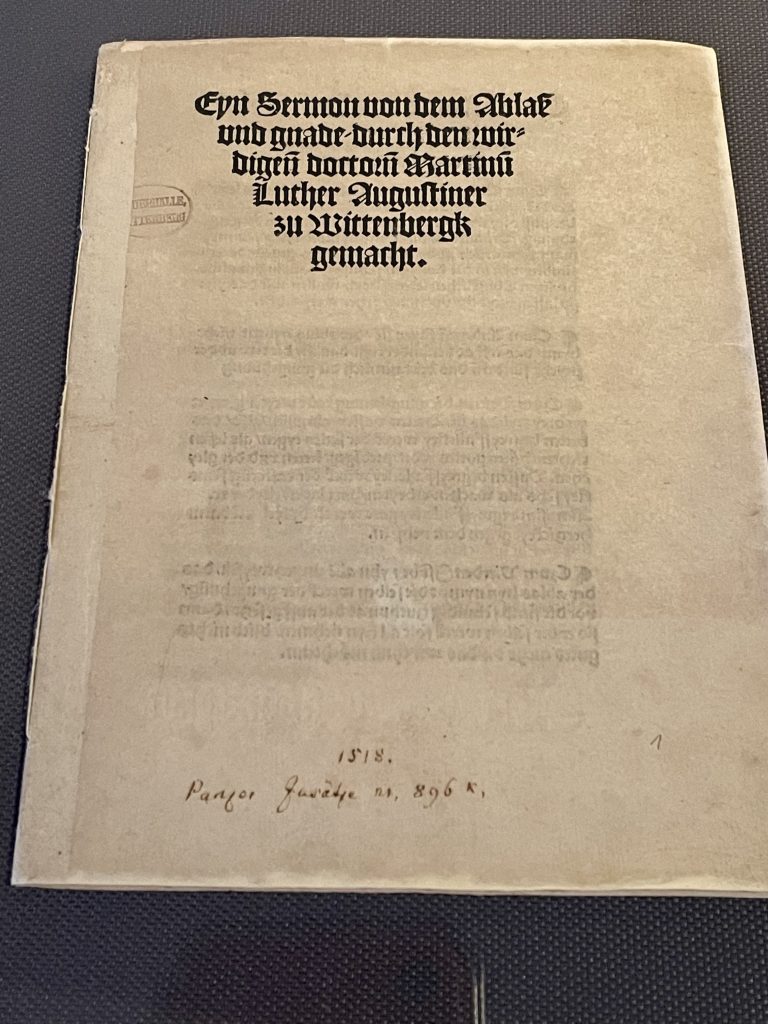
Using the printing press, Luther printed his “Sermon on Indulgence and Grace” (above) which became widely circulated. It contains a clear explanation of grace and God’s righteousness bestowed on believers that do not require works or payment.
Looking back, Luther wrote in 1541: “My theses were truly racing through all of Germany in a matter of two weeks.” Simply standing in front of these documents that literally changed the face of God’s church forever was truly humbling and inspiring.
St. Mary’s Church (Stadtkirche)
From 1512, St. Mary’s was the main place where Martin Luther preached, and the first Protestant service was celebrated there at Christmas 1521. From here, Martin Luther preached his eight famous ‘Invocavit Sermons” in the church.
The towers’ octagonal caps seen today were built in 1556-58 after the Gothic stone pyramids on them had been removed during the Schmalkaldic War so that cannons could be positioned on the platforms.
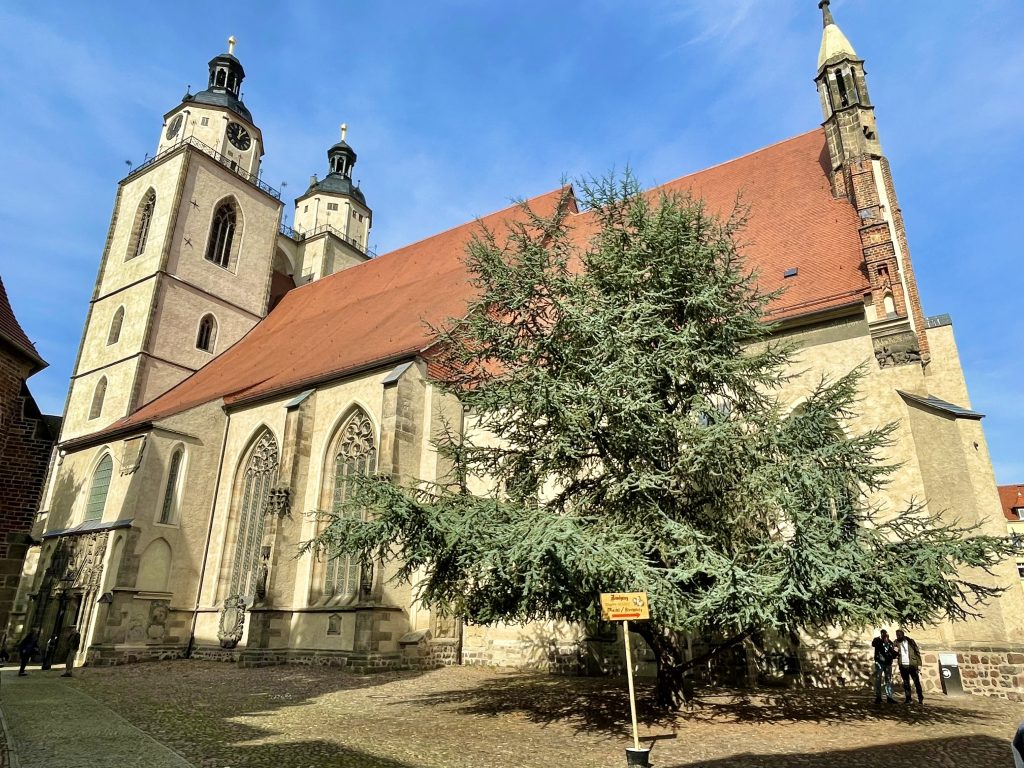
In 1525, Martin Luther and Katharina von Bora were married in the church by Johannes Bugenhagen, the town’s first Protestant pastor.
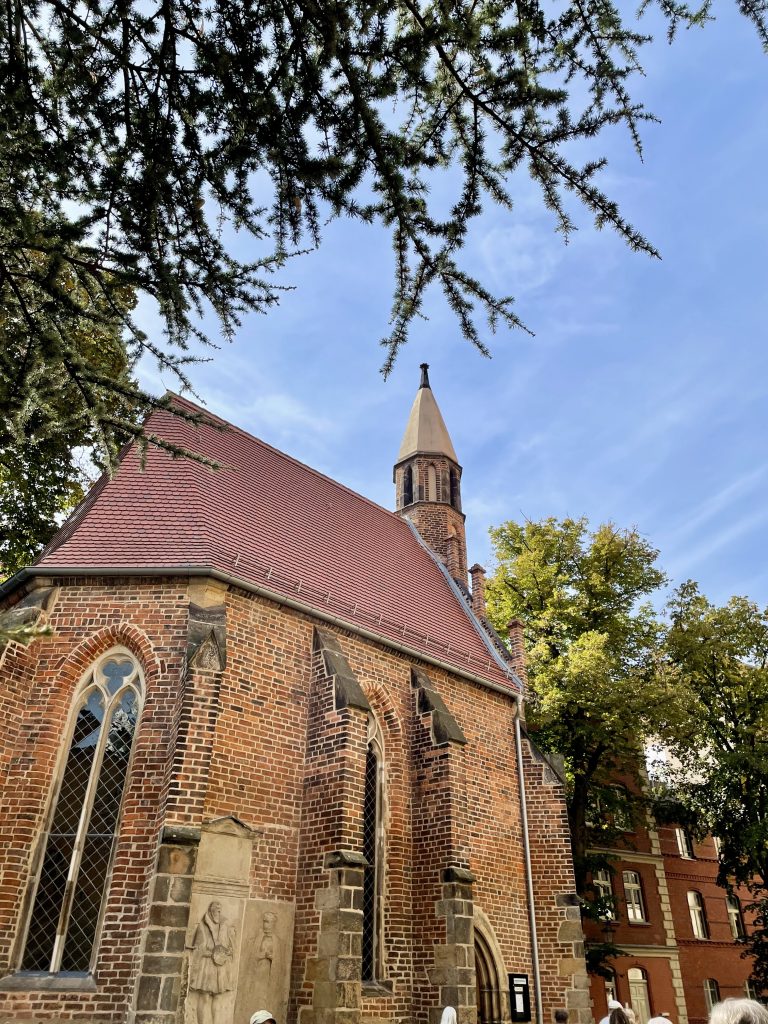
The first Protestant priests were ordained here and mass was celebrated in German there for the first time. As a result, St. Mary’s came to be known as the ‘mother church’ of the Reformation.
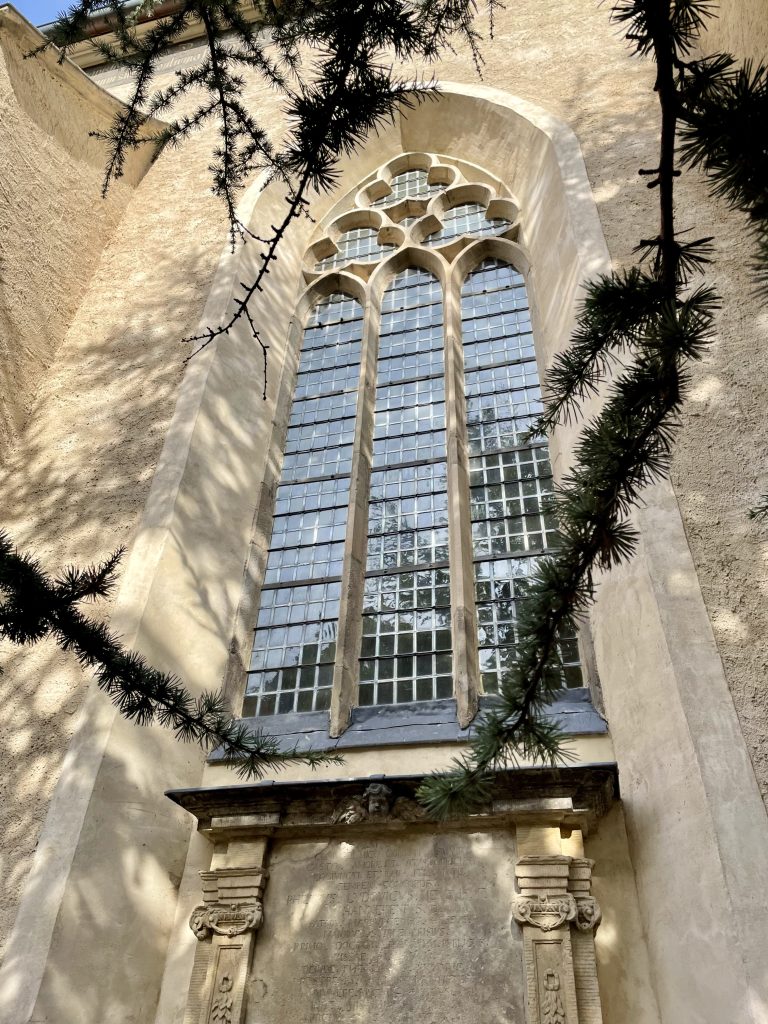
Additional rebuilding work took place in 1569-71.
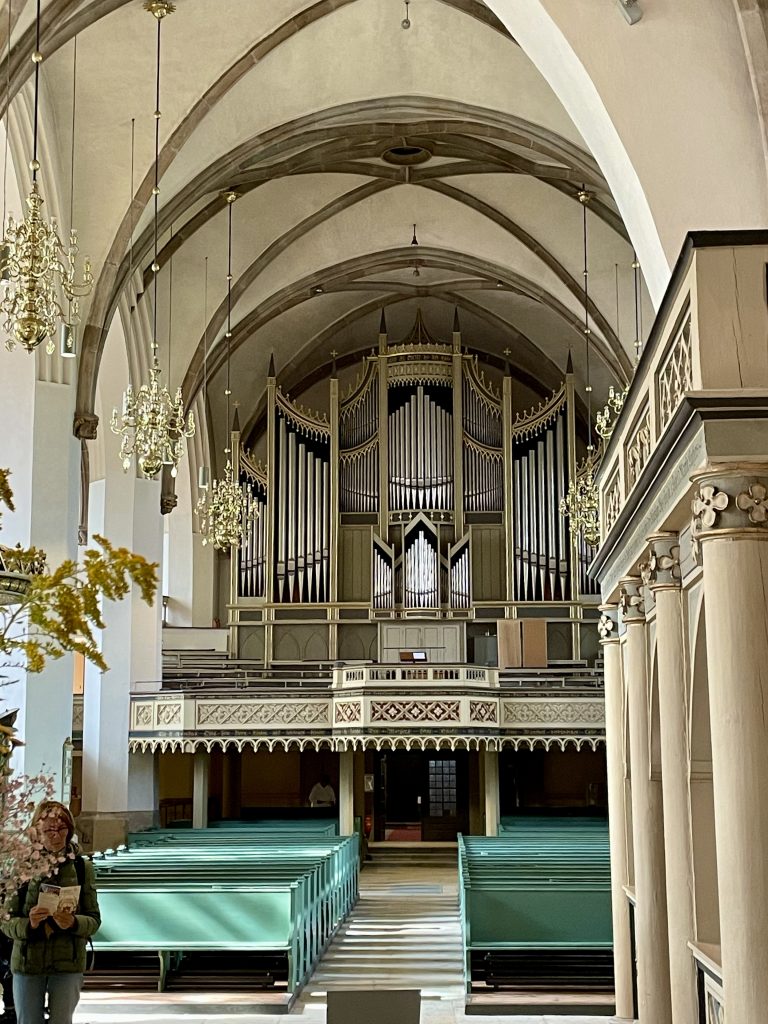
In the 19th century and the 1920s, the church’s furnishings were partly replaced. St. Mary’s Town Church was last refurbished between 2010-2016.
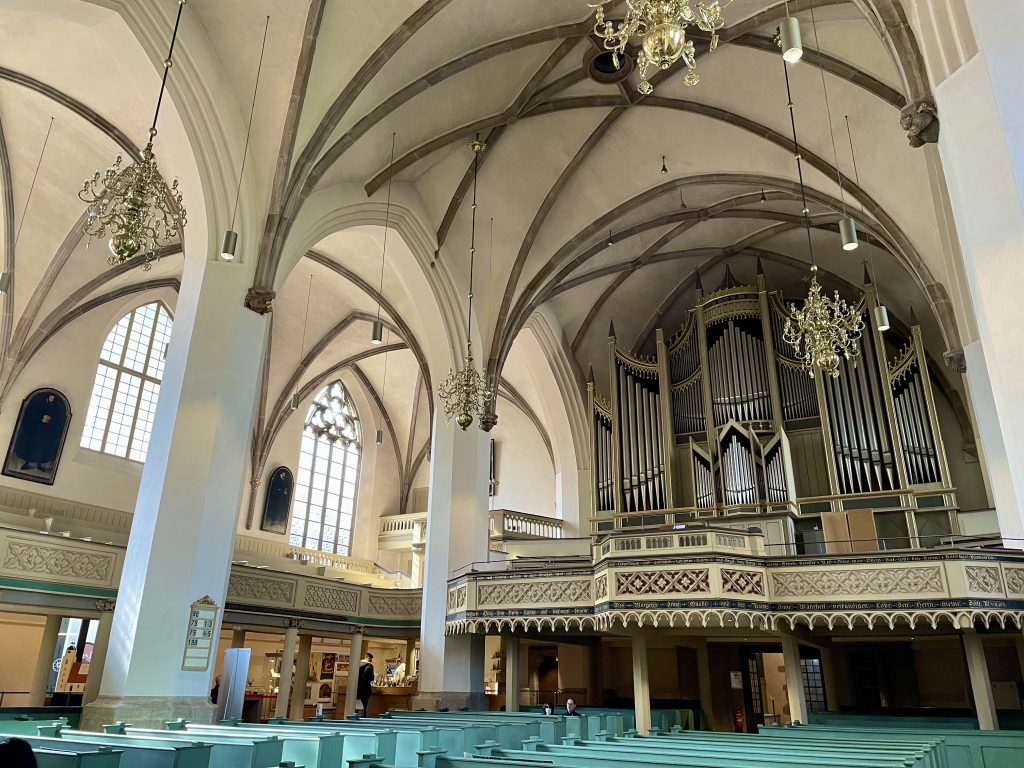
The church was named a UNESCO World Heritage Site in 1996.
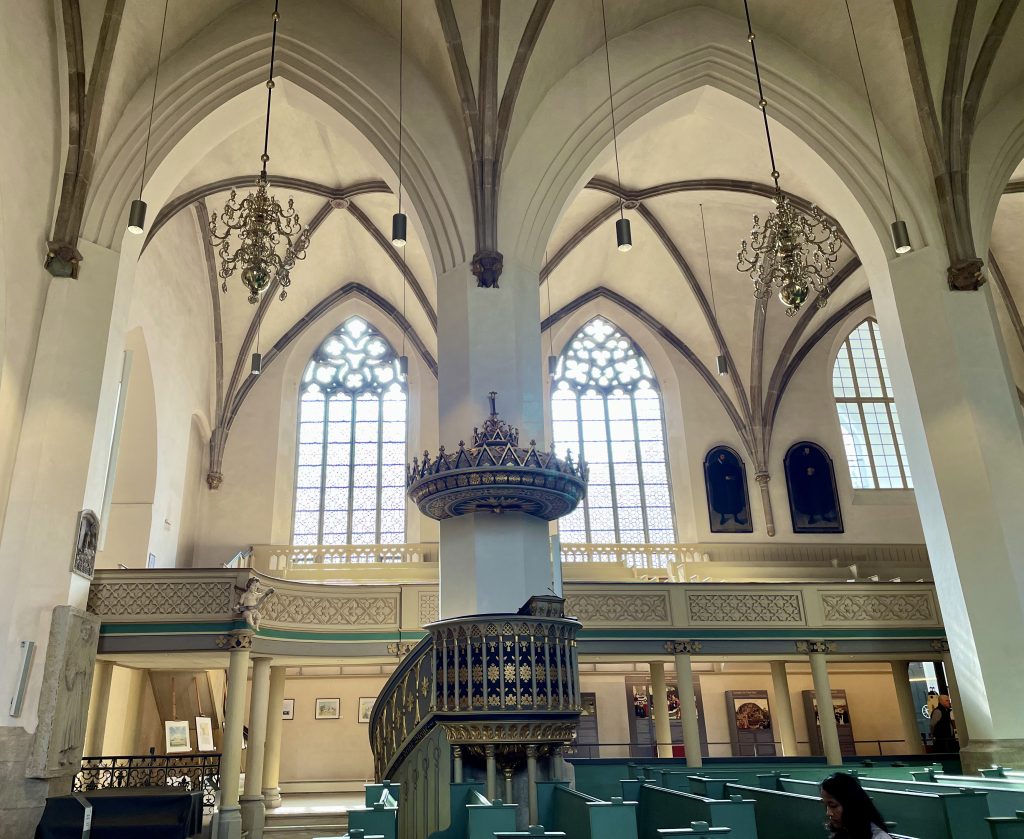
Stunning chandeliers hang in front of medieval age stained glass around the circumference of the main worship area.
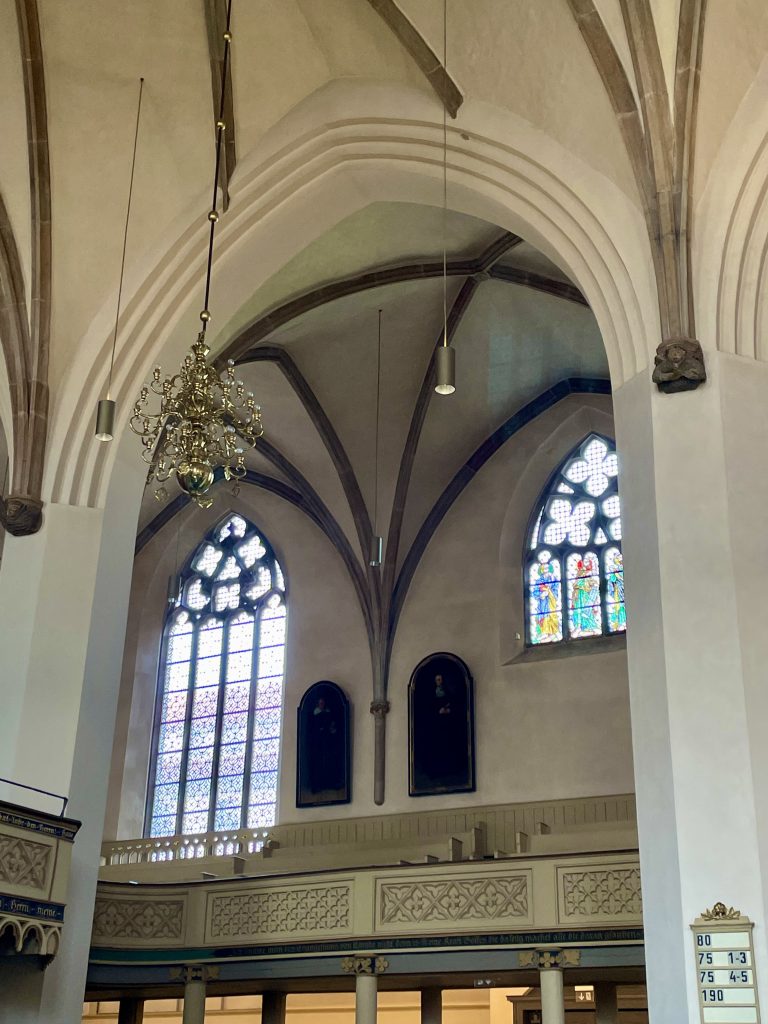
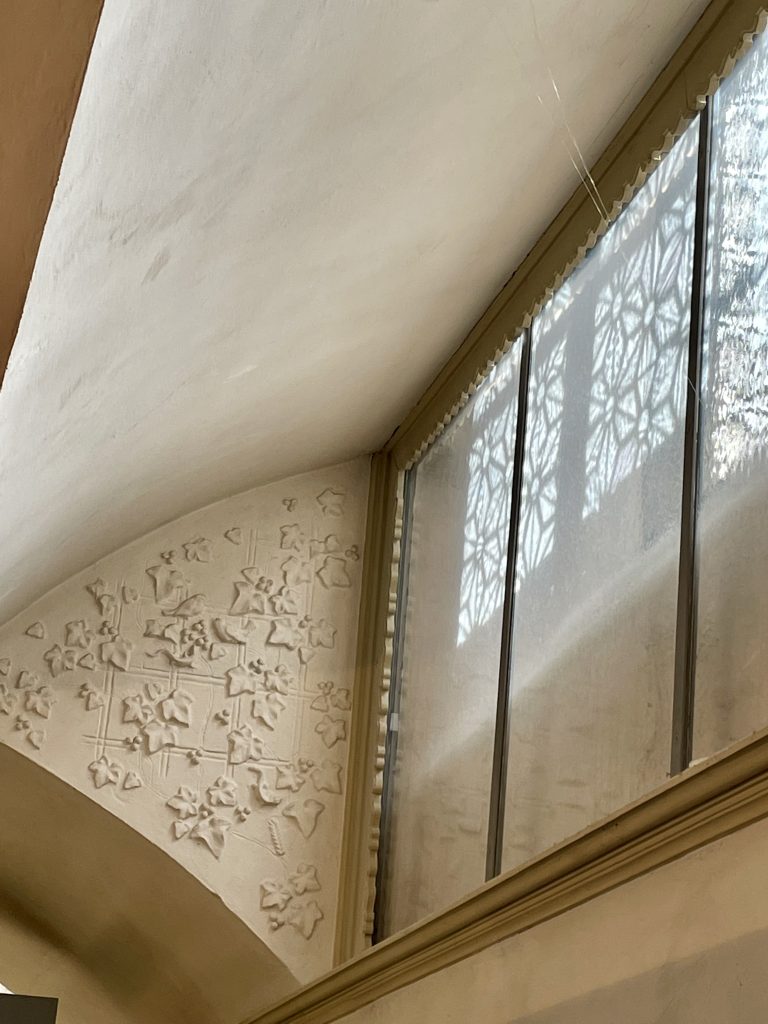
Dappled sunlight beautifully highlights the ornate plaster work high above the pews.
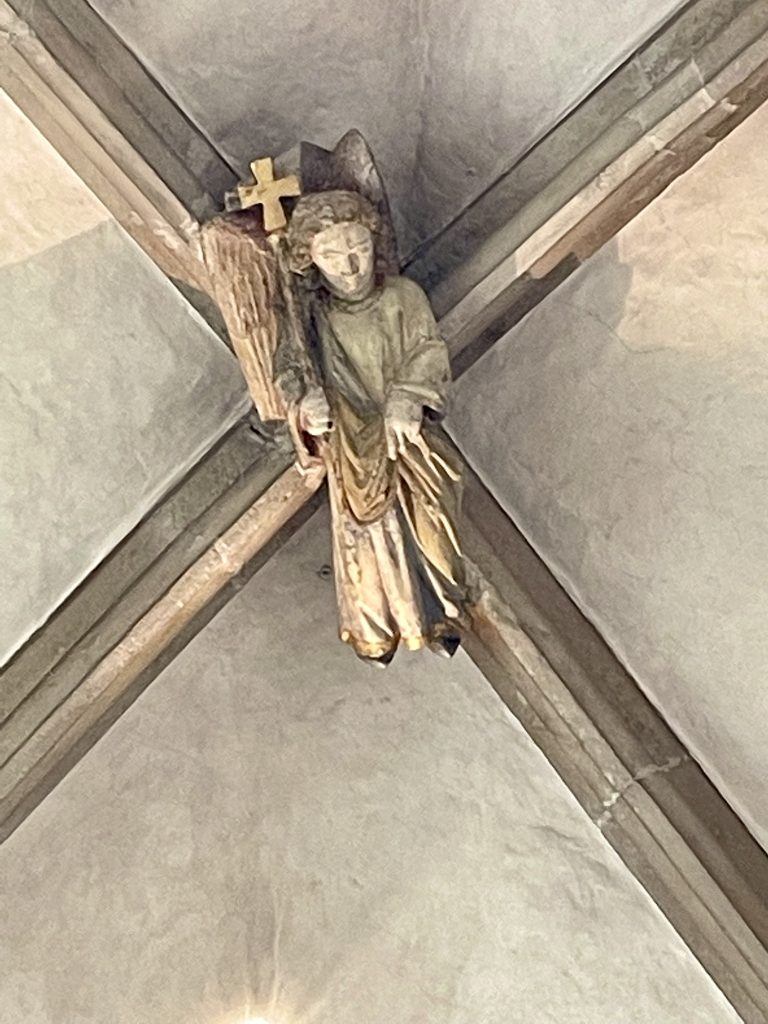
Jesus looks down over the congregation from the highest center point on the ceiling.
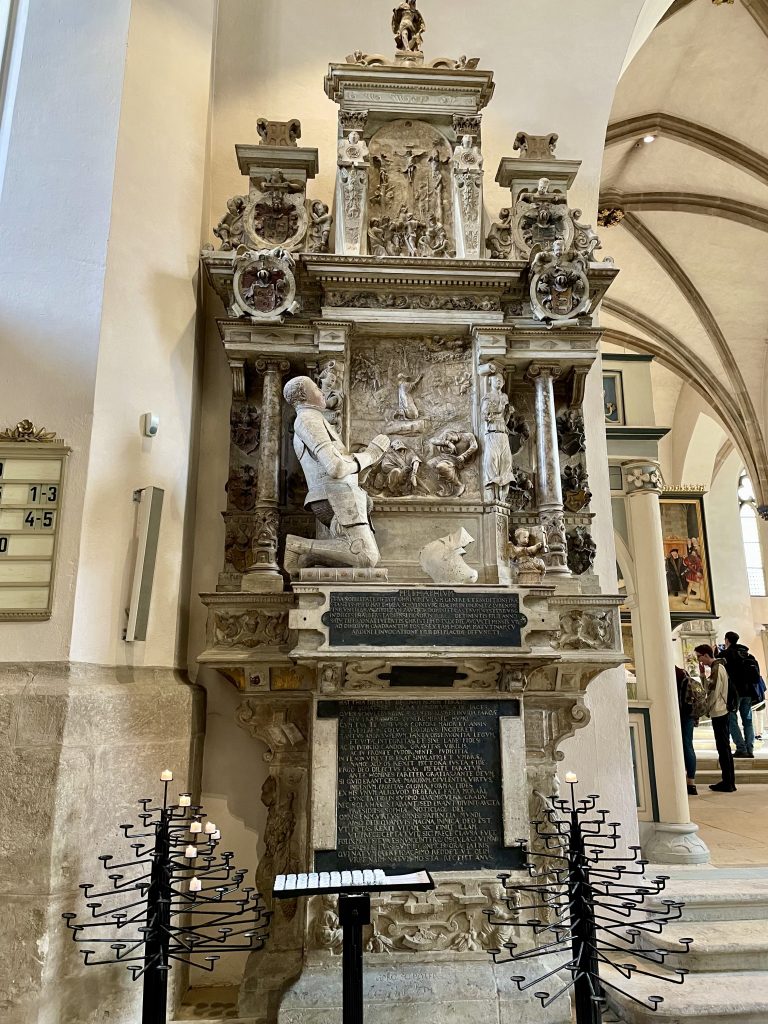
The oldest part of St. Mary’s Town Church is the present-day chancel, which was built in around 1281. Construction work on the nave began in 1412.
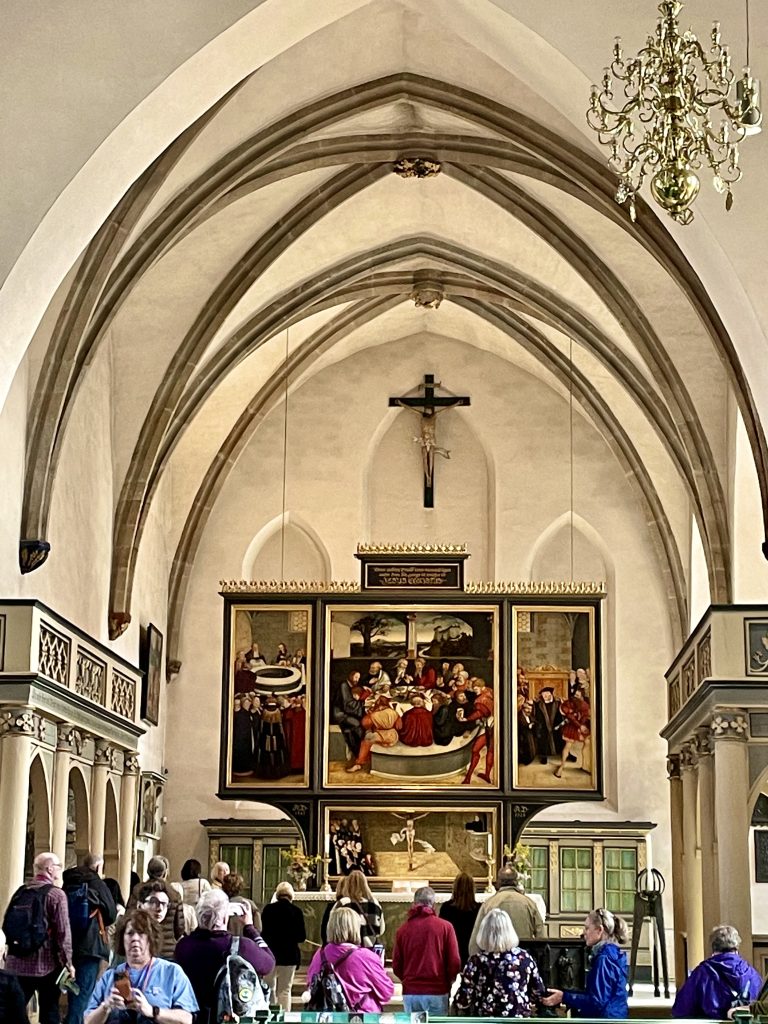
St. Mary’s famous Reformation alter was built in 1547 by Lucas Cranach the Elder and Lucas Cranach the Younger. On the display side you will find a detailed painting of the Last Supper with Martin Luther as one of the disciples. Philipp Melanchthon and Johannes Bugenhagen have also been immortalized there.
The altar presents the Reformation’s main messages, showing the sermon, Holy Communion, baptism, confession, and Christ’s crucifixion and resurrection at the center of the Christian church.
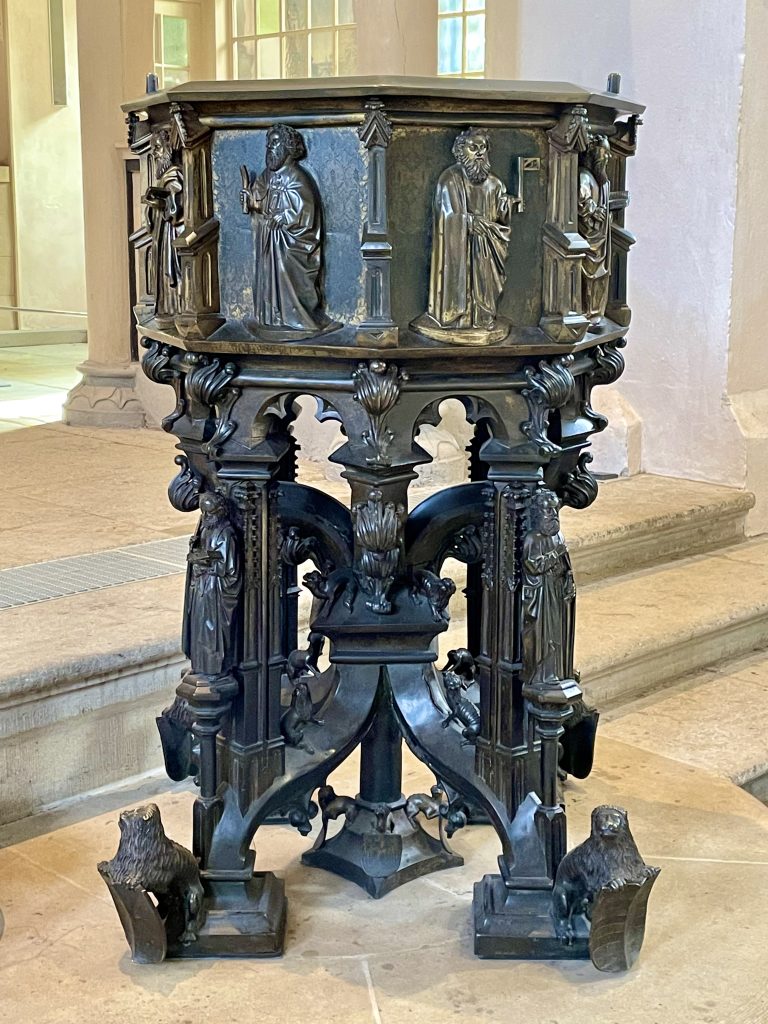
The baptismal font is an ornately decorated medieval masterpiece by Hermann Vischer, the oldest exhibit in the church. Today, the vibrant St. Mary’s Town Church is the main place of worship of the Protestant community in Wittenberg.
Our group scattered to enjoy lunch in nearby restaurants with plenty of time before strolling to the historic Castle Church.
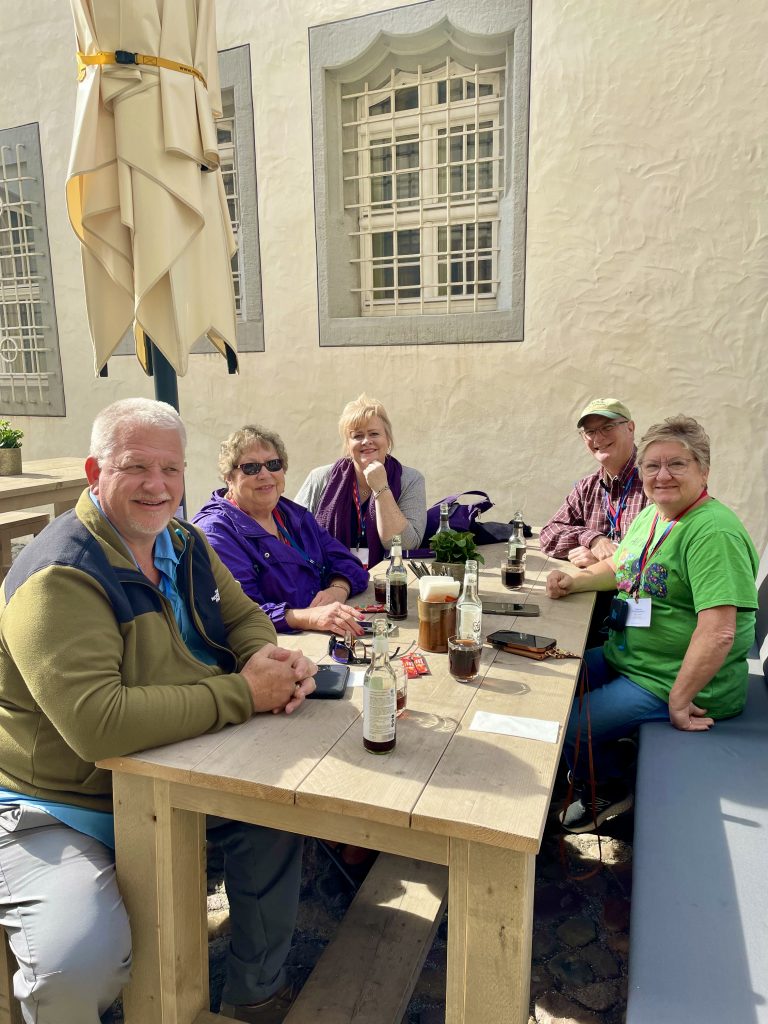
Castle Church
The castle church was built in 1506 on the foundation stones of the original castle of the Elector of Saxony. Construction of the Castle Church was completed in 1525 by Frederick the Wise. The church is most famous as the site where Martin Luther posted his 95 Theses.
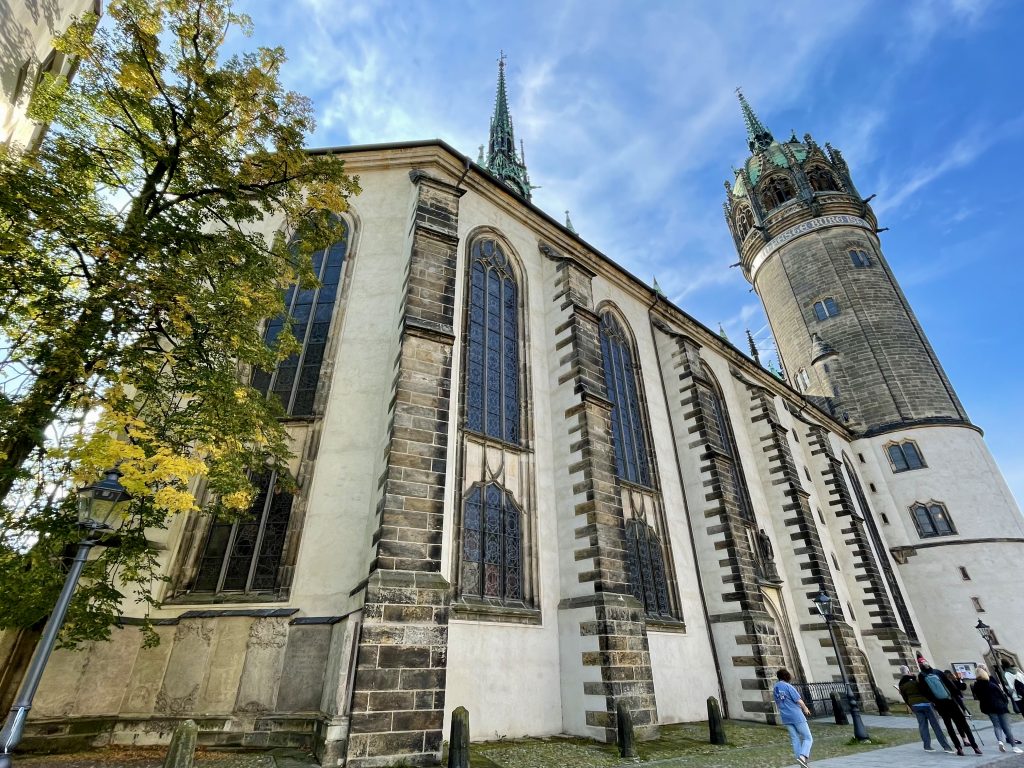
The castle tower, visible from afar, is framed by a line from one of Luther’s hymns, “A Mighty Fortress is Our God.” The tower originally belonged to Wittenberg Castle along with a second tower that has been removed.
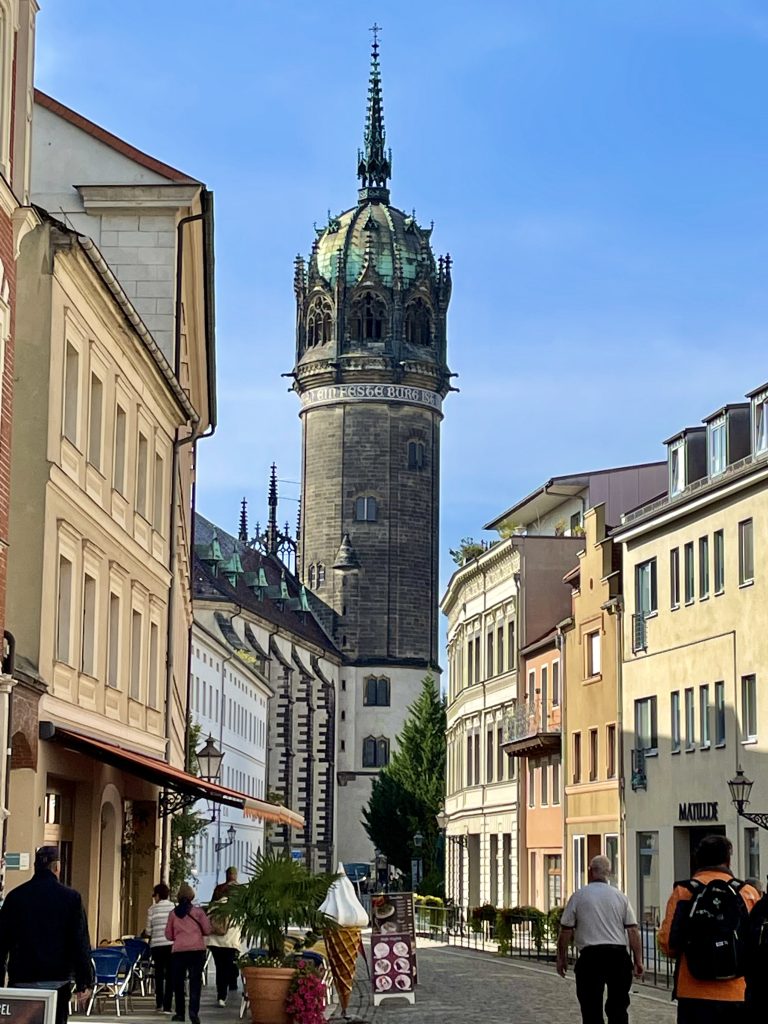
In 1760, the church was destroyed by a fire resulting from an attack during the Seven Years’ War. The wooden doors on which Luther had posted the Theses were destroyed in the fire. In 1858, King Frederick Wilhelm IV of Prussia replaced them with commemorative bronze doors weighing 2,200 pounds each.
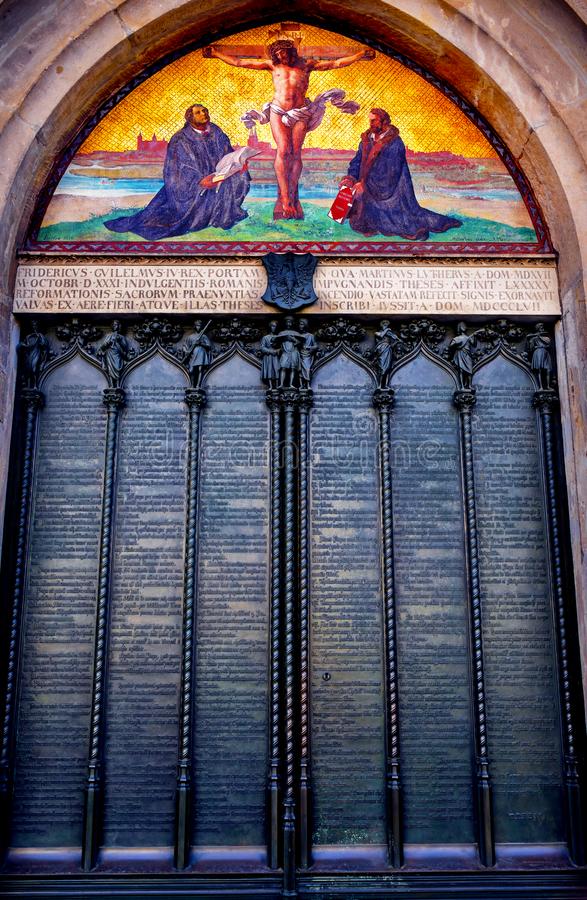
Displayed above the doors is a painting depicting Martin Luther holding a German Bible and Melanchthon holding the Augsburg Confession. Both are kneeling at the cross.
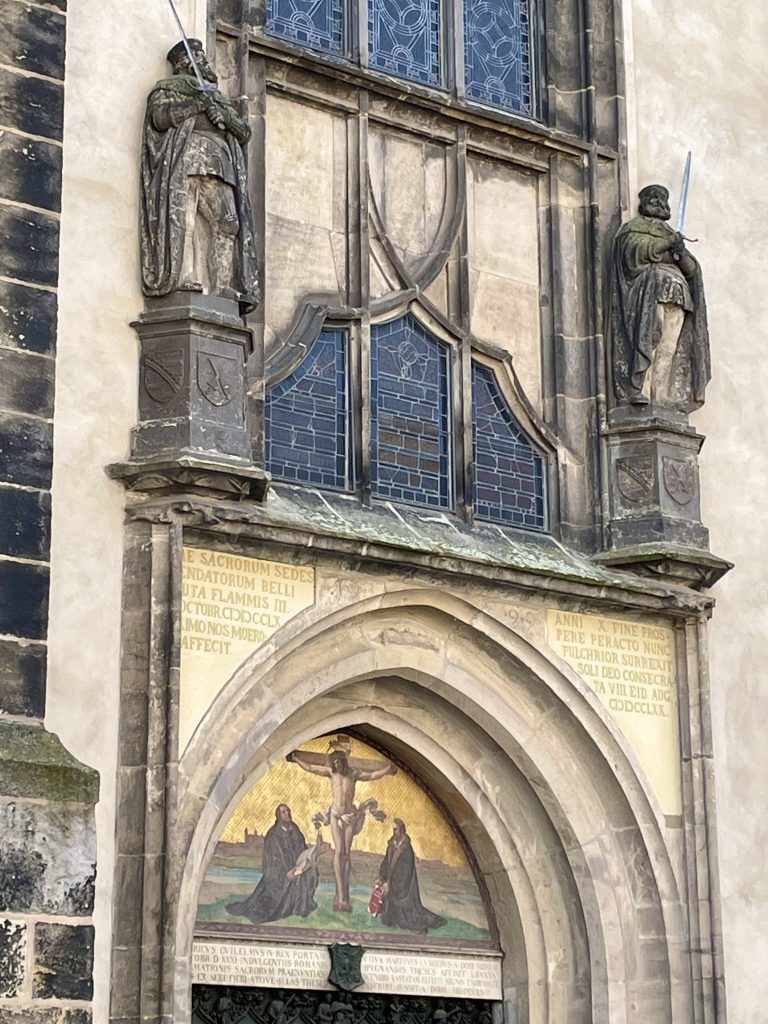
This view from the inside (below) where the doors hang today are not passable by visitors in order to preserve the heavy bronze doors.
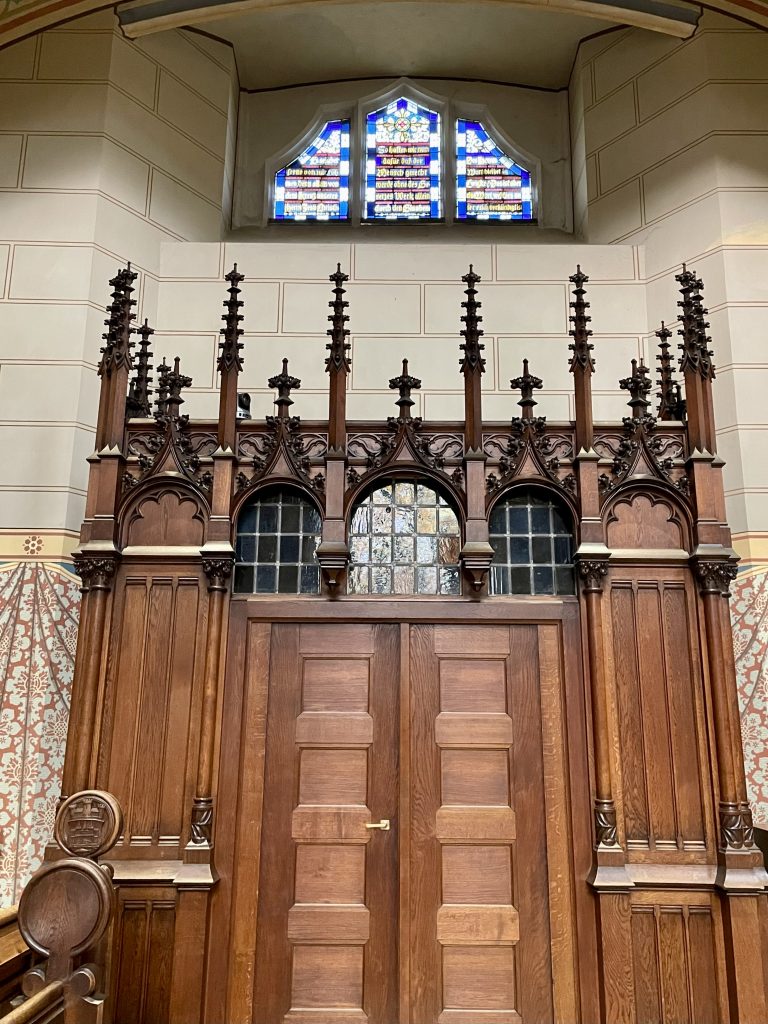
Between 1885 and 1892 the church was redesigned in a new gothic style as a Memorial Church of the Reformation.
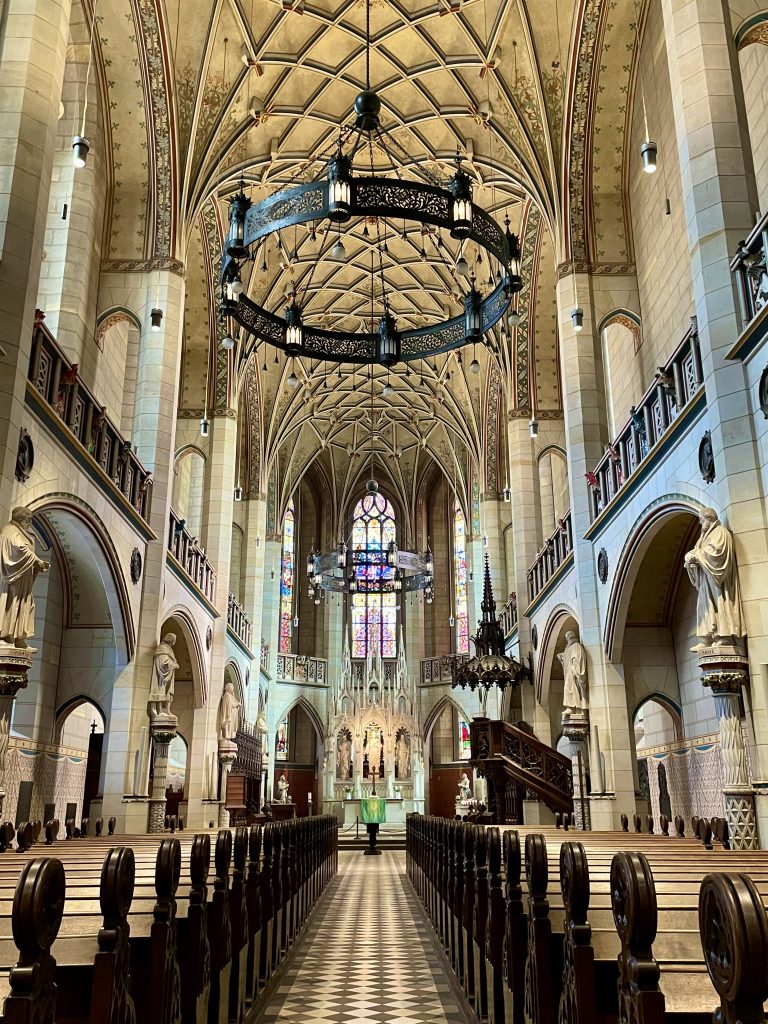
In 1996 the Castle Church was designated as a part of the UNESCO World Heritage site.
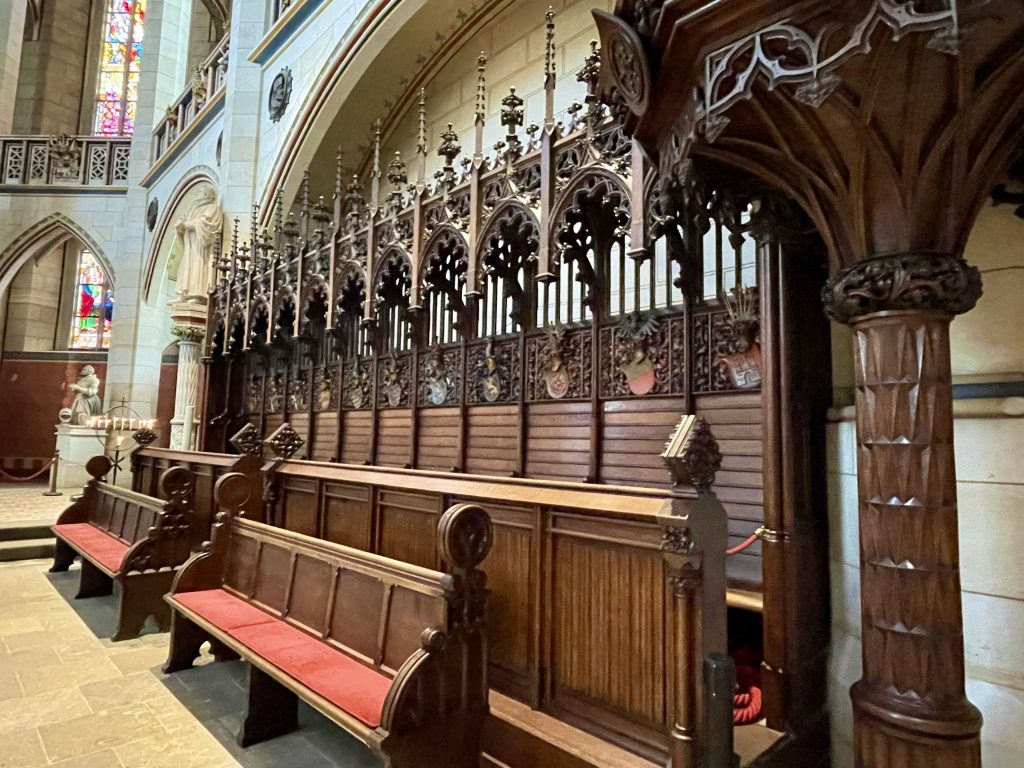
The stunning organ and beautiful frescos add ambience and loveliness to this house of worship.
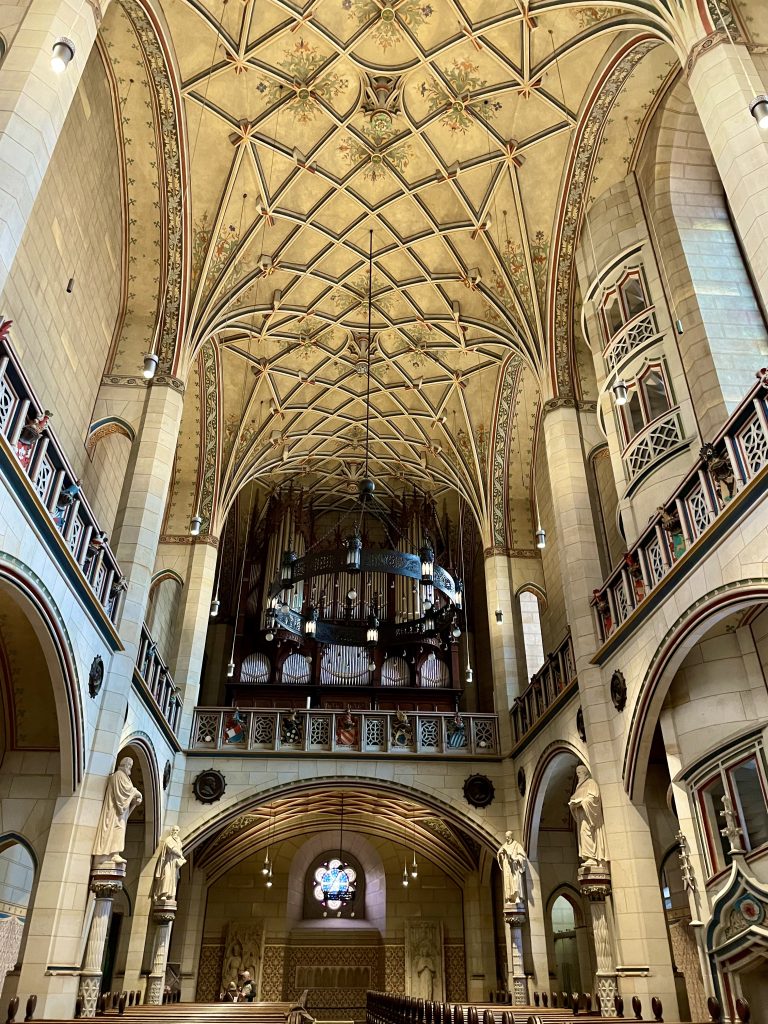
Martin Luther’s Tomb
Four days after Luther’s death in Eisleben, he was buried in front of the pulpit in the Castle Church. Next to Martin Luther’s grave is the resting place of his friend and fellow reformer, Philipp Melanchthon.
He is laid to rest under a low stone marker right under beautiful stained glass windows. As I taught our group who sat in the pews, the sun shone through the stained glass and cast beautiful colors on the floor around his marker.
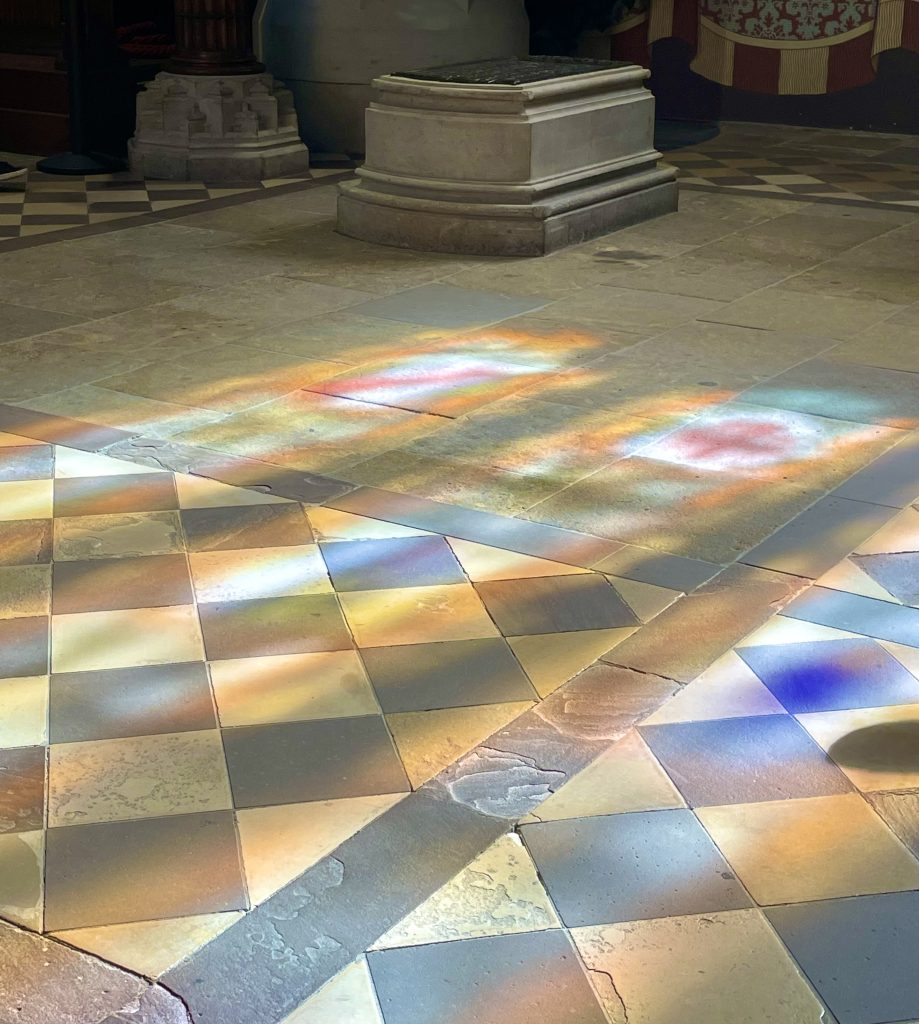
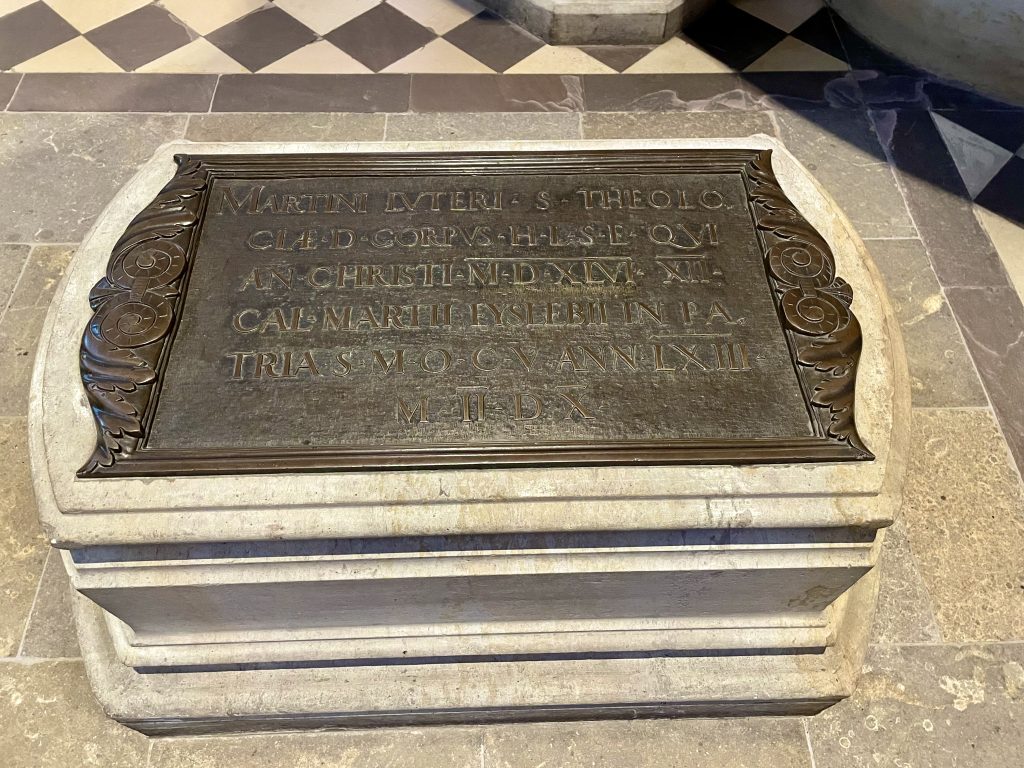
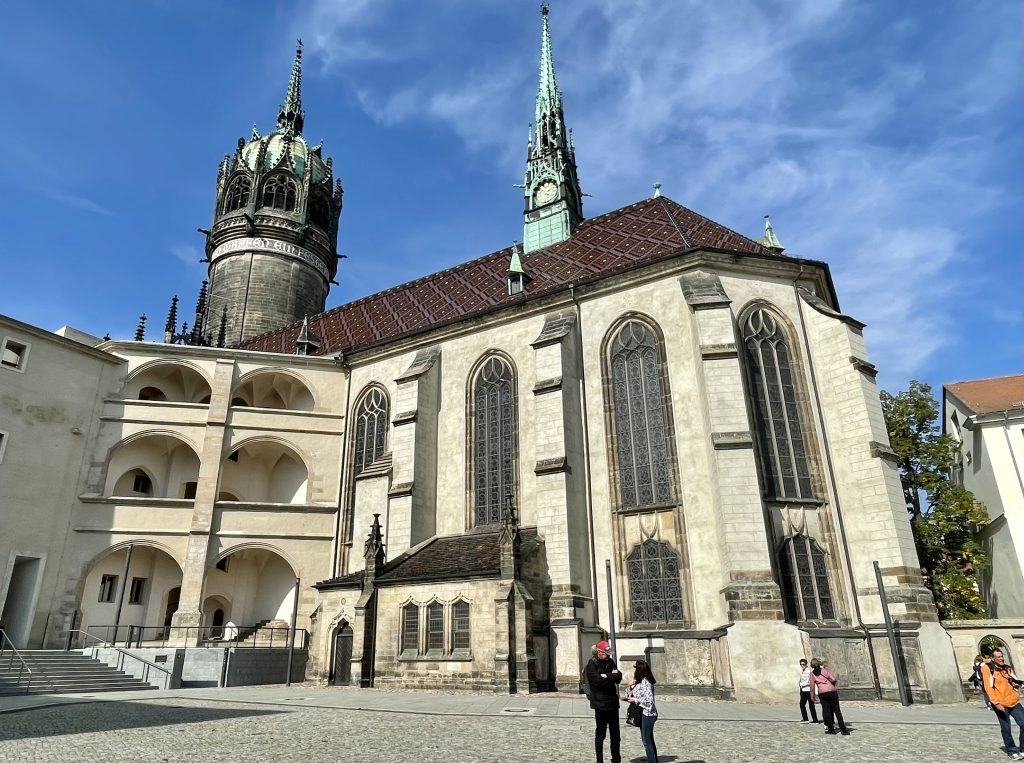
The Old Latin School
During our afternoon free time, several of us visited the Old Latin School, which was built in 1564 as the city school for boys. It is managed by the International Lutheran Society of Wittenberg as a non-profit organization in partnership with the Lutheran Church-Missouri Synod. It is yet another bright spot in this beautiful city.
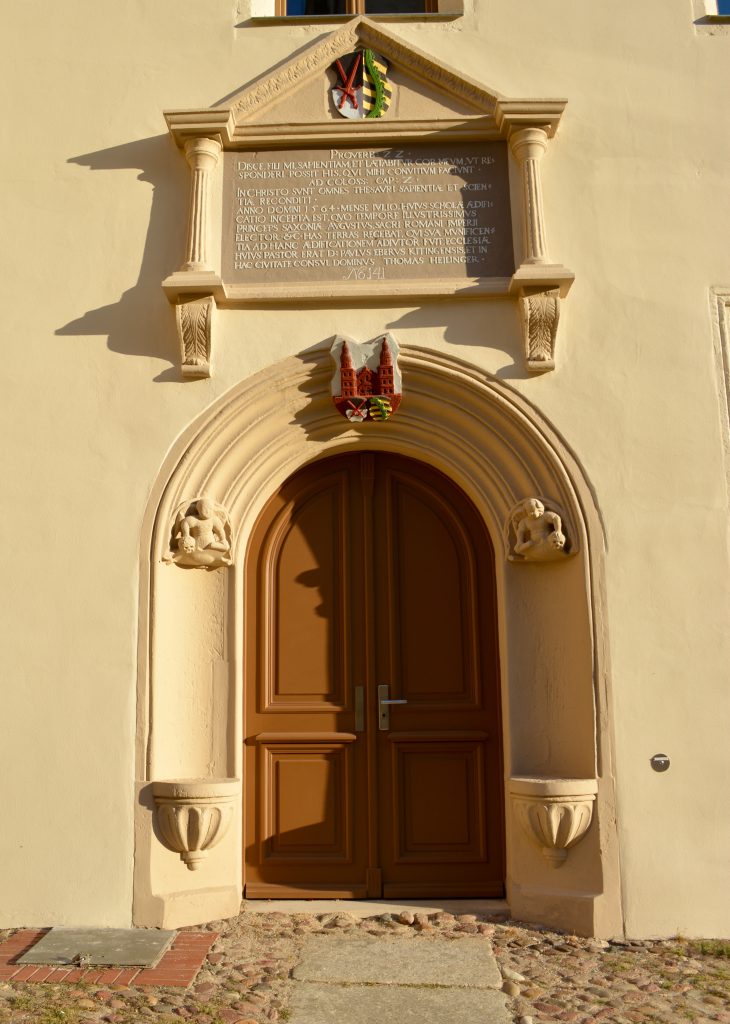
The Old Latin School sits directly adjacent to St. Mary’s Church (Stadkirche) where Martin Luther and other reformers preached a life-changing message of grace alone, faith alone, through Christ alone. Stemming from the new approach to education being taught by the Wittenberg reformers, the Old Latin School. The church and school were truly central birthplaces of the Reformation.
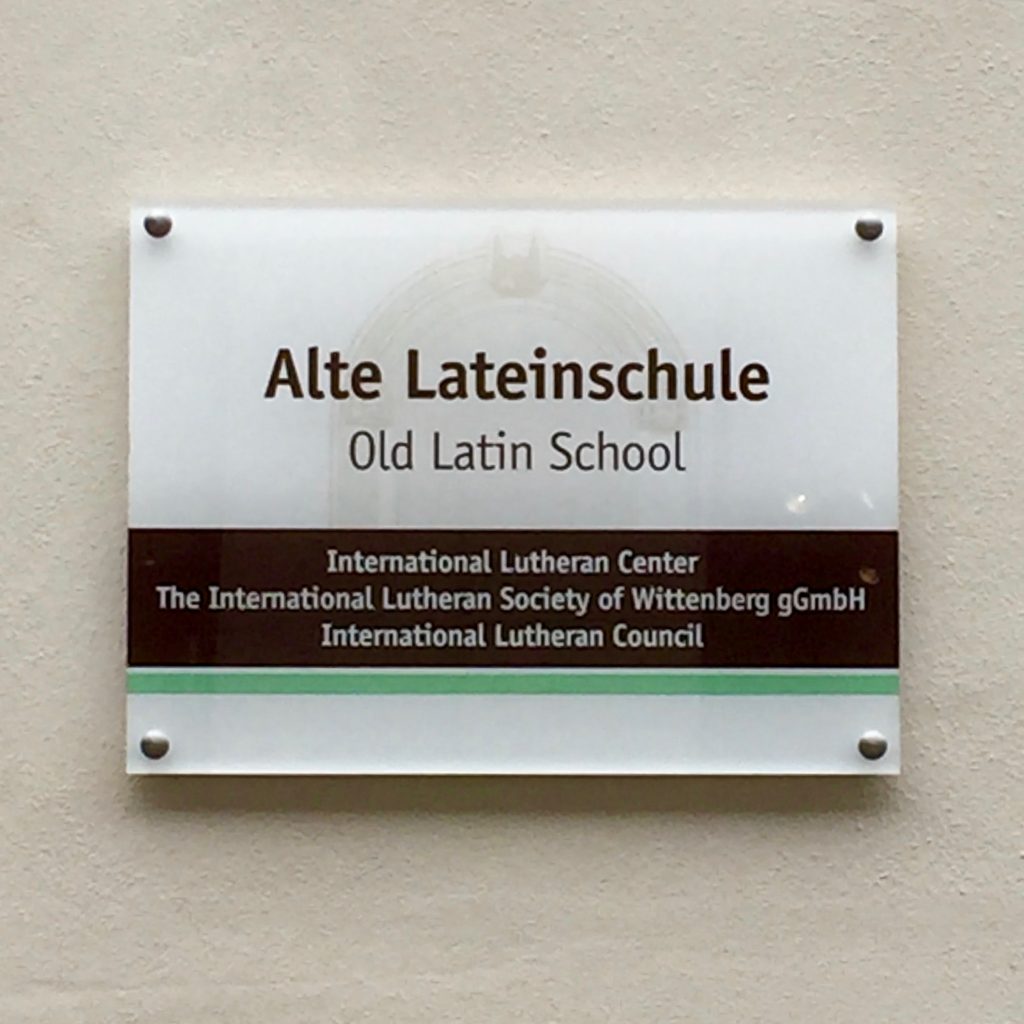
Special Ministry Connection
By the grace of God, I have a special ministry connection to the Old Latin School. Through WordRus ministries in Eurasia, several of my Bible studies have been translated into Ukrainian. As only God can orchestrate, the Old Latin School is currently housing many Ukrainian refugees. During our afternoon break, several in our group walked over to the school to meet Netalyia, who not only runs the school but is a Ukrainian refugee herself.
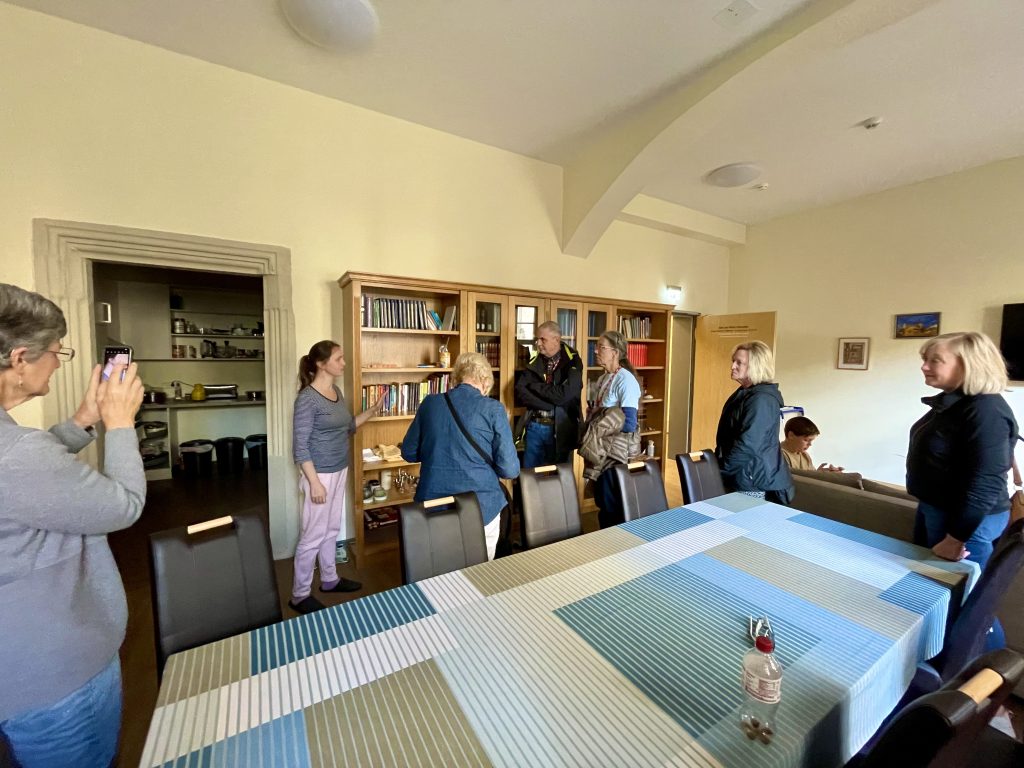
A Cambridge-educated teacher, she is proficient in English and has been a huge blessing for the refugees as she helps them with their required paperwork and begins the process of teaching them English.
We met her 11-year-old son and 8-8year-old daughter and are amazed at their positive, gentleness after escaping the war that rages in their homeland right now. We had a chance to leave them a financial blessing and pray with them for God to continue blessing their work.
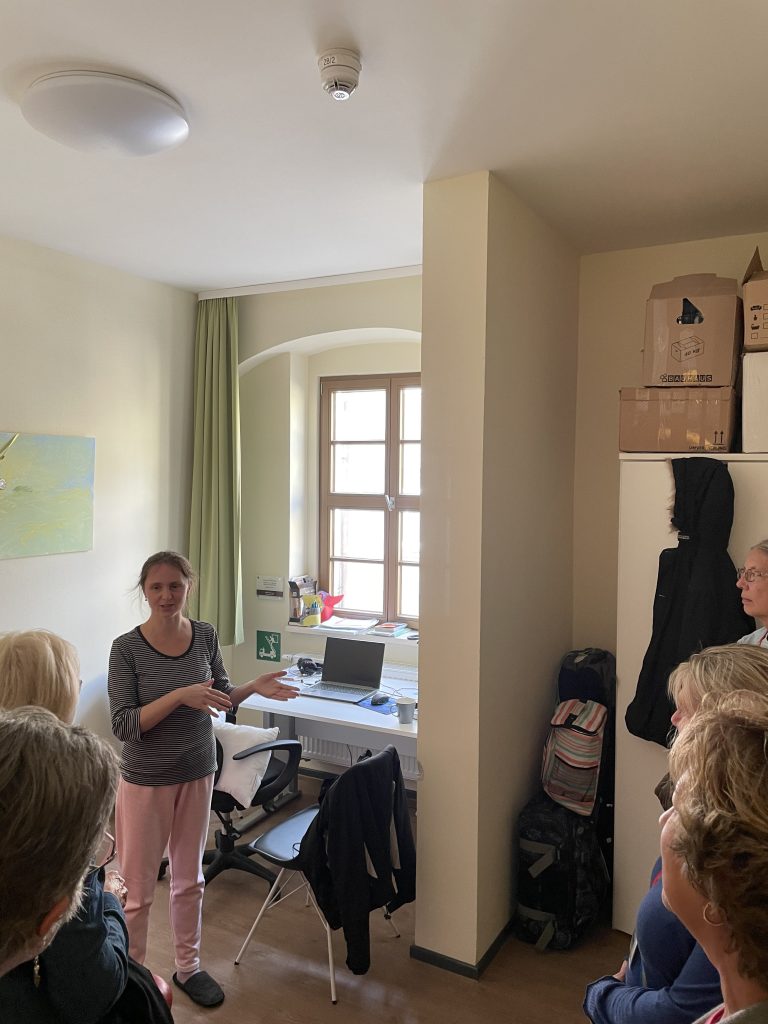
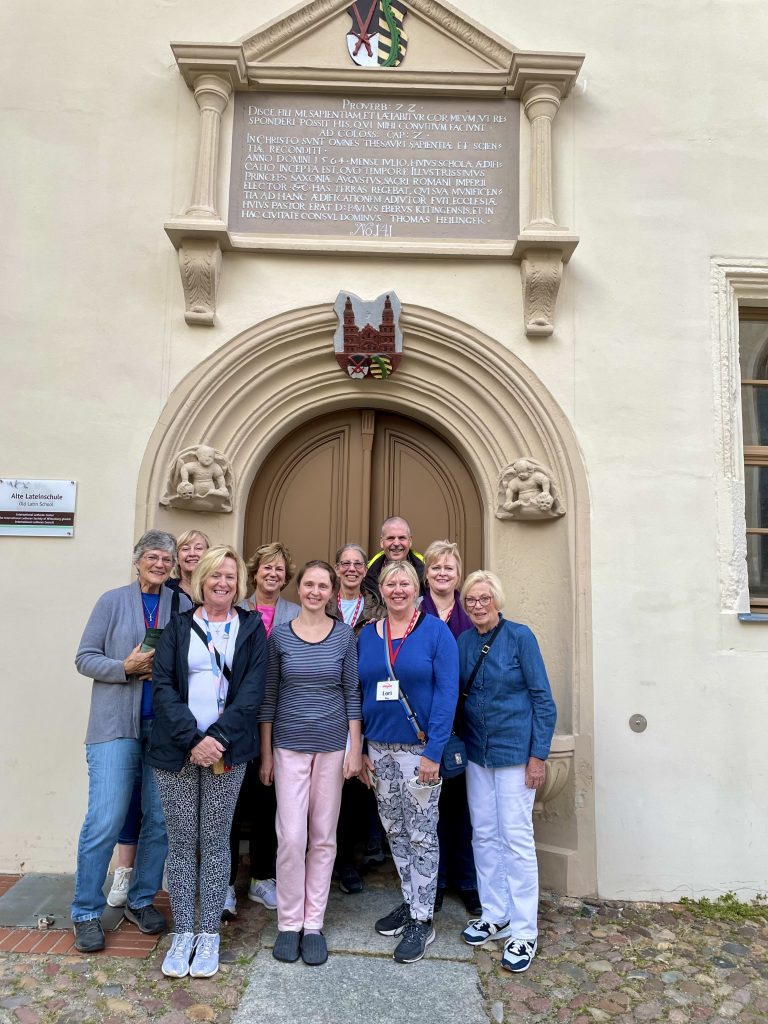
It’s a Good Idea to Visit Wittenberg
Although there are no fairytale castles here like the Neuschwanstein Castle, being in the epicenter of the Protestant Reformation is a thrill of a lifetime. This is a great spot to enjoy rich history and beautiful historic sites within walking distance! This is one of the most charming small towns and hidden gems that I have ever visited.
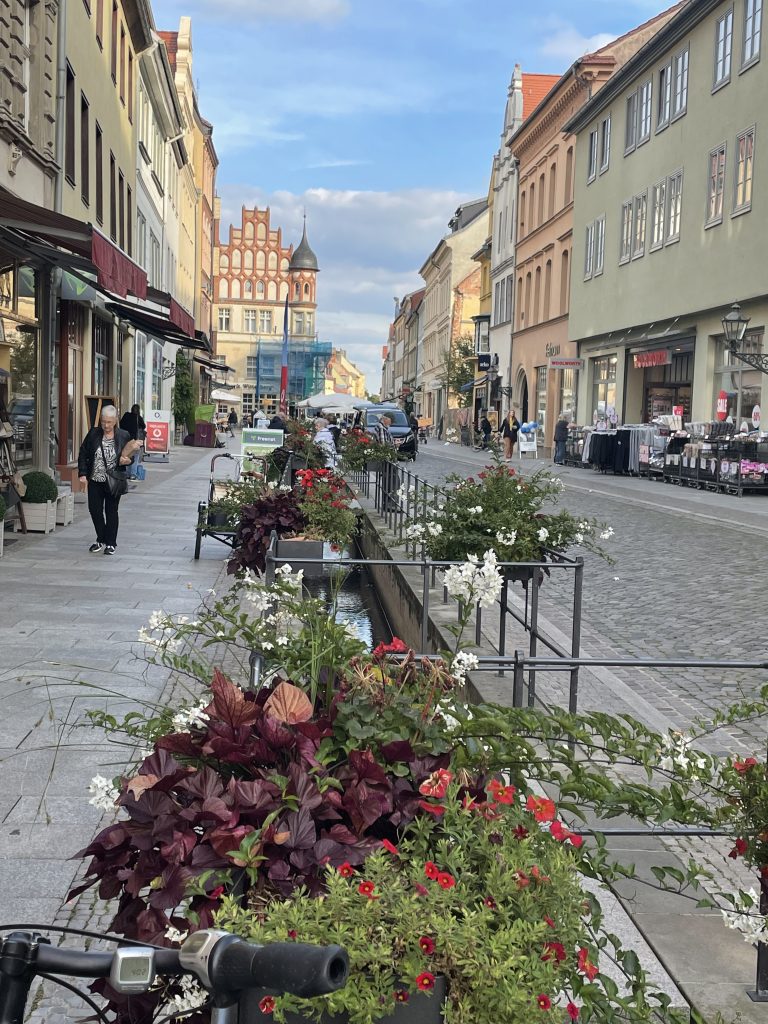
If you are traveling here, it is an easy road trip or day trip with an early start and train ticket from many locations. Public transportation is easily accessible due to the train station just outside the city. I highly recommend adding it to your Germany itinerary to step back into the Middle Ages.
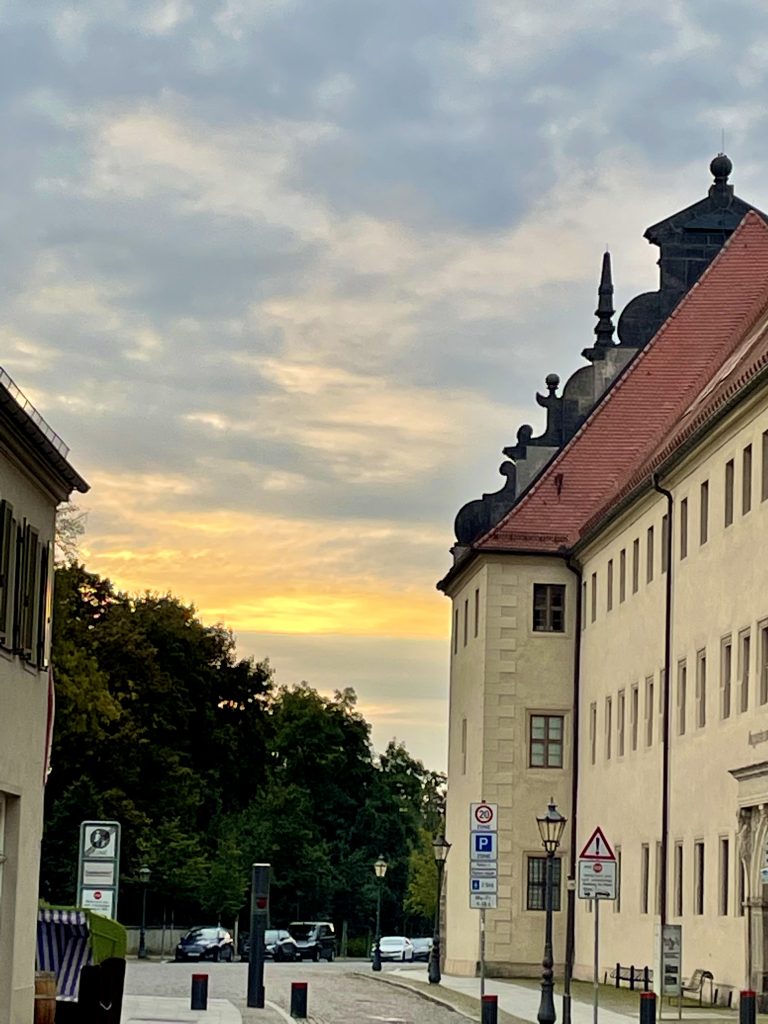
We concluded our walking tour passed the town hall and city center, then enjoyed a good time exploring the town on our own. We had a great time!
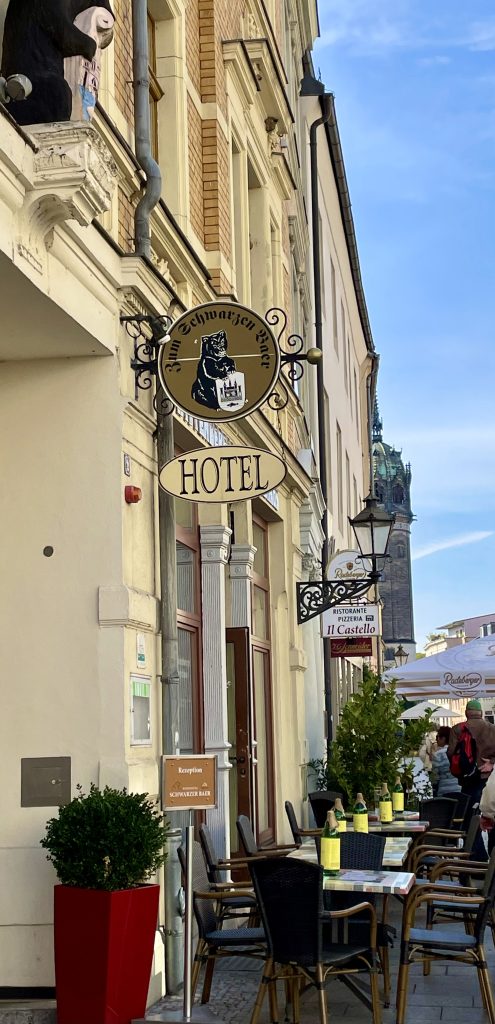
And even though we were here in September, it would be a lovely trip during the sunny days of the summer months. If you prefer medieval towns to bigger cities, don’t miss out on this small city jewel called Wittenberg on your next Germany trip.
Related Posts:
- Best Bible Reading Plans
- Warriors in the Bible: 13 Essential Life Lessons to Learn
- 50 Motivational Bible Verses About Aging Gracefully
About the Author
Although Donna is a Lutheran and sought-after Bible teacher, her path from being unchurched to become passionate about sharing Jesus was not easy. Go here to read her God-breathed journey, “From Unchurched to Becoming a Multi-Published Author and Sought-After Speaker.” If you want to send Donna a quick message, then visit her contact page here.
{Some of these links are affiliate links. This means if you make a purchase through that link, the ministry may receive a small commission at no extra cost to you. Thank you for your ministry support!}
